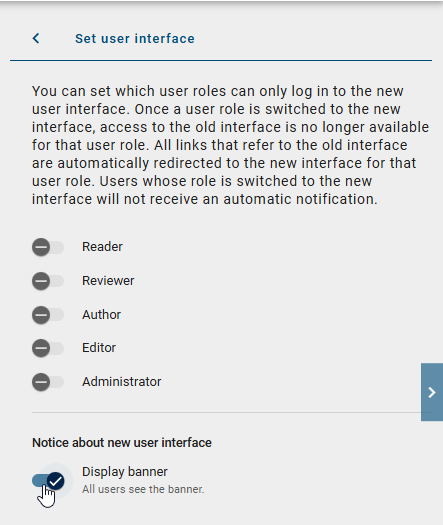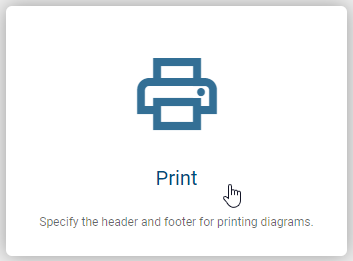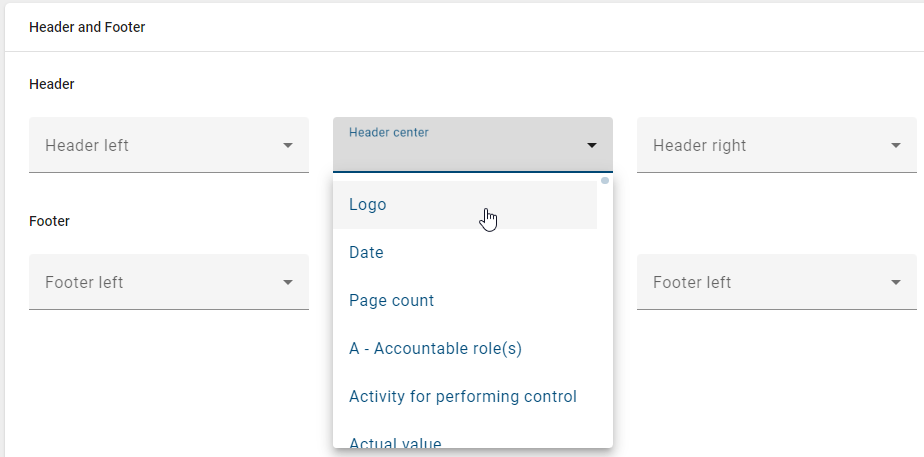Administration
The administration can be reached via the menu item named Administration.
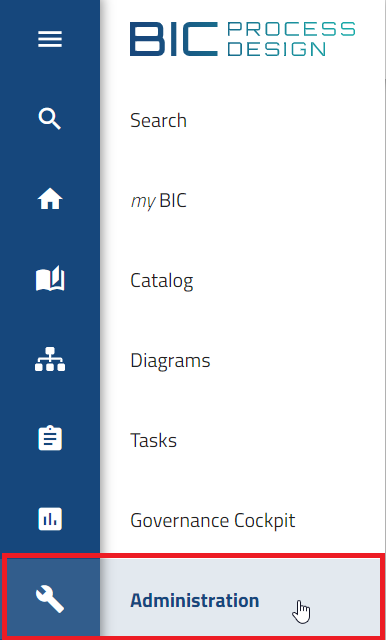
You can use the breadcrumb navigation in the administration. If you have opened a tile of the administration, you can switch to the start page of the administration via the header bar.
Users
If you are an Administrator and open the Administration menu item in the left menu bar, you will see a collection of predefined tiles. If you click on the first tile, Users, you will find an overview of all existing users.
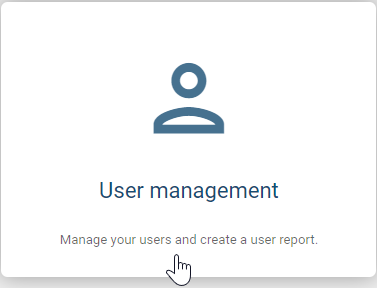
This overview contains the user name, the BIC Process Design user role, the set user language and the email of the respective user. If required, you can also edit the user details of a user, delete a user or reset the password of a user.
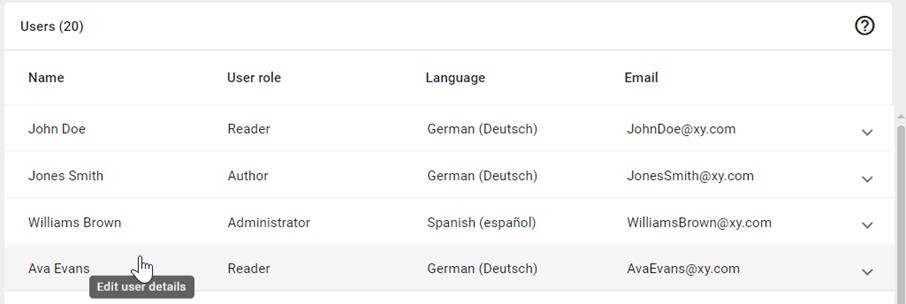
In the right sidebar, you will find the Filters and Options tabs. In the Filters tab, you can search for specific users and filter the users by their BIC Process Design user role. Via the Options tab, you have the option to create a user and create a user and license report.
Currently, you can also use the Options tab to specify which users only have access to the new user interface. Further information on the respective functions can be found in the linked sections.
Hint
Please note that the functions of the Users tile are not available in the mobile view.
How can I create a user?
If you are an Administrator and open the Administration menu item in the left menu bar, you will see a collection of predefined tiles. In the Users tile, you have the option to create new users.
To create a new user, switch to the Options tab in the right sidebar and click on the Create user option.
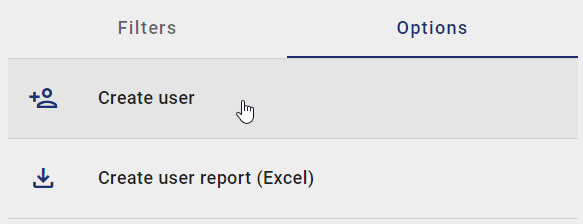
This will open a dialog where you need to enter the user’s name and email address. Additionally, you have the option to set the user’s language and assign the BIC Process Design role. Furthermore, there is an option to create the user via SSO.
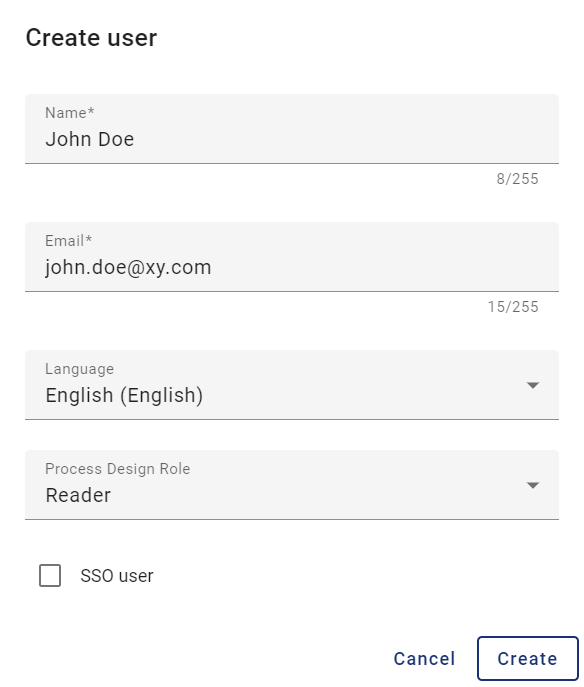
To create the user, click on the Create button. Alternatively, you can discard the entry using the Cancel button.
The new user will now be displayed as the first entry in the list. Upon reloading the page, the user list will be displayed in alphabetical order.
How do I edit a user’s details?
If you are an Administrator and open the Administration menu item in the left menu bar, you will see a collection of predefined tiles. In the Users tile, you have the option to edit the user details of a user.
By clicking on a user in the list view, you can view, define or change their user details. This includes Name, Email, Language, Process Design Role, Process Execution Role, and the Assigned user groups. You can find out which permissions the BIC Process Design and BIC Process Execution roles have here.
Navigate to the list of users and select the user whose details you want to edit to view their user-specific information.
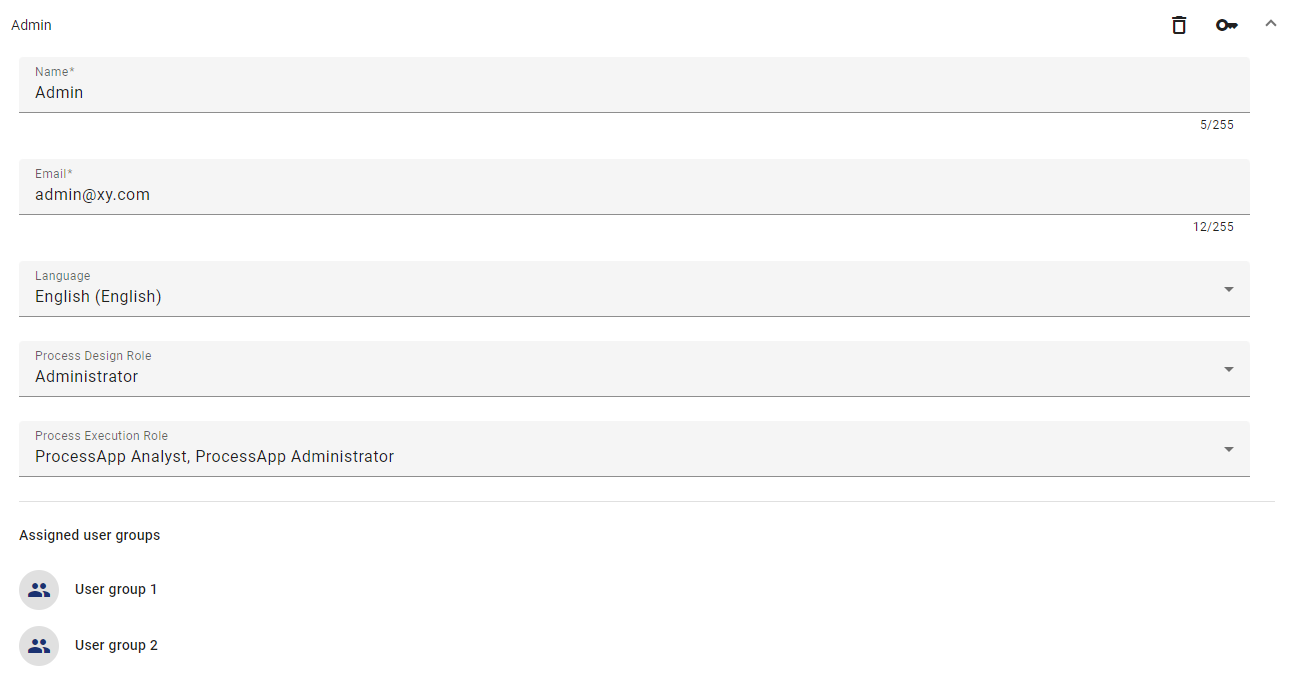
You can define or change the user details in the respective input fields. The fields Name and Email are mandatory fields and must always be filled in.
After making a new setting, it will be saved directly, and you will receive a success message. If the saving fails, you will receive an error message.
Note
Please note that you cannot edit a user’s assigned user groups here. You can find out how to add a user to a user group or remove a user from a user group in the linked sections.
Hint
Please note that the language set is the content language in which the application is displayed to the user by default. The emails from the application will also be displayed in this language.
Which user roles are available and which permissions do they have?
In general, you have five different user roles for Process Design, with different authorizations that build on each other. Your active user role is displayed on the MyBIC page under your name or in the profile.
Reader: Readers only have access to the publication stage. This means these users are able to see published diagrams and all attributes, symbols, catalog entries and documents which are associated with these diagrams. In the publication area readers can create comments and reports and also use the print preview function. In addition they can add diagrams to their favorites.
Reviewer: Reviewers have similar access to the publication stage as Readers and possess the same permissions. Additionally, Reviewers have access to the preview stage and can view and work on assigned governance tasks (publication, depublishing, resubmission) if they are designated as a reviewing authority for a specific diagram or catalog entry. However, Reviewers are unable to initiate a governance workflow themselves.
Author: Authors have essentially the same rights as Reviewers. They also have access to the public workspace. This allows them to see all catalog entries and diagrams in the public workspace. This generally allows them to model diagrams and automatically generate catalog entries. To use these features, users with the Author role must be entered as Author in the attributes of the corresponding diagram or object. This allows Authors to be used specifically for modeling individual diagrams or editing individual objects.
Editor: Similar to authors, the role of Editor is used to edit and create diagrams. Unlike authors, Editors do not have to be set within the diagram attributes to model a diagram. Additionally, editors have the ability to make cross-diagram changes. This means users with the role of Editor have the right to manually create, edit, or delete catalog entries and are authorized to accept or decline catalog entries. Furthermore, editors have the ability to assume administrative tasks for governance workflows. They have the authority to view and manage all governance workflows. In the governance cockpit, editors have the same rights as administrators, which means they can delegate or cancel workflows.
Administrator: Administrators have all the rights that other user roles have. In addition, they have special administration rights. These include access to the administration area, the right to create, delete, and rename repositories, as well as the ability to unlock diagrams.
Accessible workspaces |
Administrator |
Editor |
Author |
Reviewer |
Reader |
|---|---|---|---|---|---|
Public workspace |
entitled |
entitled |
entitled |
not authorized(*) |
not authorized(*) |
Preview |
entitled |
entitled |
entitled |
entitled |
not authorized(*) |
Publication |
entitled |
entitled |
entitled |
entitled |
entitled |
(*)Read-only access can be granted to individual diagrams in the public workspace (view share diagram from public workspace)
If you use BIC Process Execution, you have the possibility to set the user’s role for this application as well.
ProcessApp Administrator: As a ProcessApp Administrator, you have access to the administration area and can manage all available options.
ProcessApp Analyst: As a ProcessApp Analyst, you have access to the monitoring dashboard and can monitor all processes.
ProcessApp Creator: As a ProcessApp Creator, you can model executable processes in Process Design. If you want to further edit a diagram and you have this role, you have the possibility to open the editor by right-clicking an activity in the context menu. Alternatively, you can also open the editor by selecting the activity and choosing the Editor section from the Details menu. There, you will find a button that allows you to open the editor. Only users with the ProcessApp Creator role have the option to use the Test ProcessApp button in the preview stage or in the public workspace within the diagram view in Process Design and work on tasks.
ProcessApp User: As a ProcessApp User, you can initiate processes and see how far along they are. You can use the Create Case button in the diagram view of Process Design at any stage and work on tasks if you have the ProcessApp User role.
ProcessApp Participant: As a ProcessApp Participant, you can have active tasks and work on them, but you cannot initiate tasks.
Warning
Please note that both the ProcessApp User role and the ProcessApp Participant role are currently required to edit and manage tasks.
Hint
Please note that these roles are not hierarchical. This means that if, for example, you are assigned the role of ProcessApp Administrator, you do not automatically have access to the rights of other roles. To obtain additional rights, you need to select multiple checkboxes of the Process Execution roles.
How can I delete a user?
If you are an Administrator and open the Administration menu item in the left menu bar, you will see a collection of predefined tiles. In the Users tile, you have the option to delete existing users.
To delete a user, at least one user must exist. Click on the desired user in the list to expand their user details. You will then see the option Delete user at the top right.
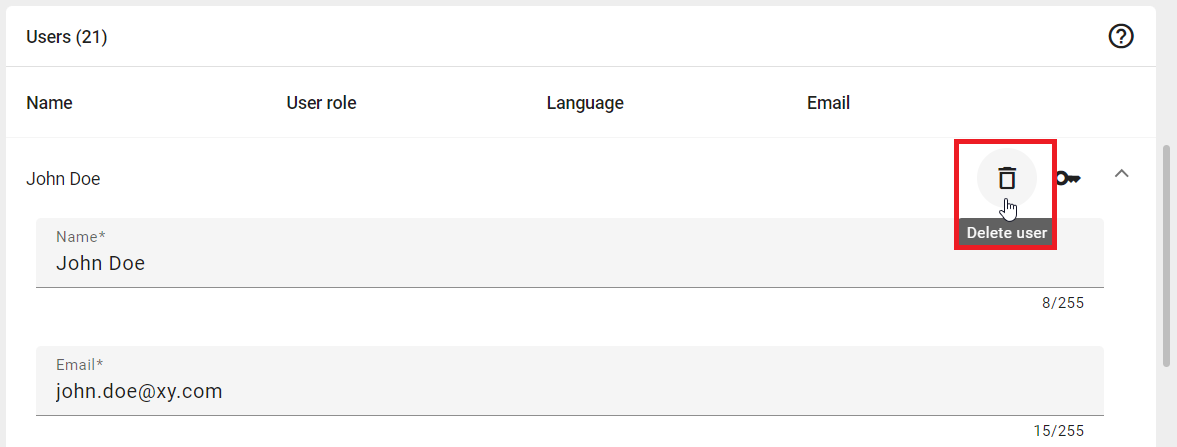
Then, a dialog opens, asking you to confirm the deletion. Click on the Delete button to finally confirm the deletion or on the Cancel button to cancel the deletion.
Afterward, the user will be permanently deleted and removed from the list.
How can I reset a user’s password?
If you are an Administrator and open the Administration menu item in the left menu bar, you will see a collection of predefined tiles. In the Users tile, you can reset a user’s password.
To reset a user’s password, navigate to a user in the list and expand their user details by clicking on the user. You will then see the option Reset password at the top right.
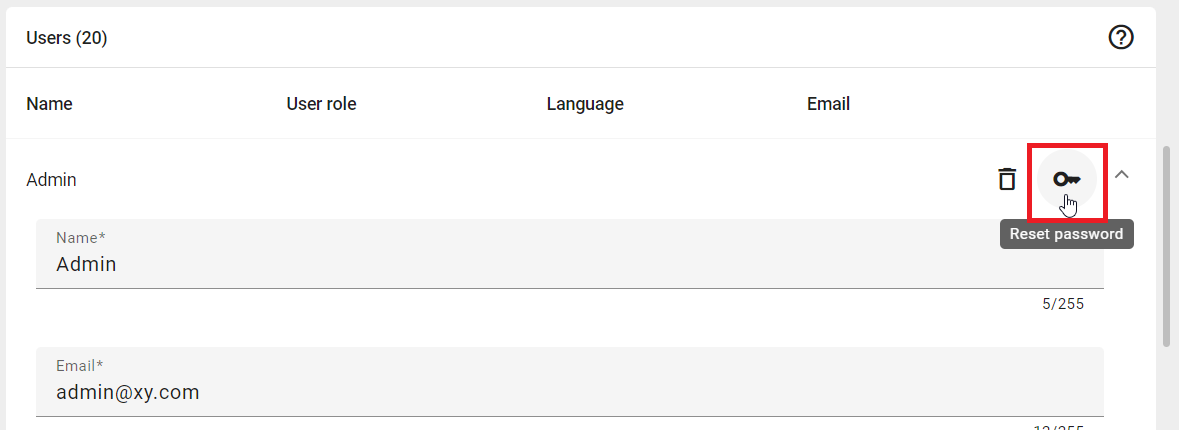
After you clicked the option, a dialog appears. Click the Reset button in the dialog to automatically send an email to the selected user with instructions on how to reset the password. If you wish to cancel the process, click the Cancel button.
How can I filter by user roles?
If you are an Administrator and open the Administration menu item in the left menu bar, you will see a collection of predefined tiles. In the Users tile, you have the option t filter the list of users by their user roles.
In the right sidebar you will find the Filters tab by default. The Process Design Role filter is displayed there, and you can select which user role you want to filter by. You also have the option of searching for specific users using the search field.
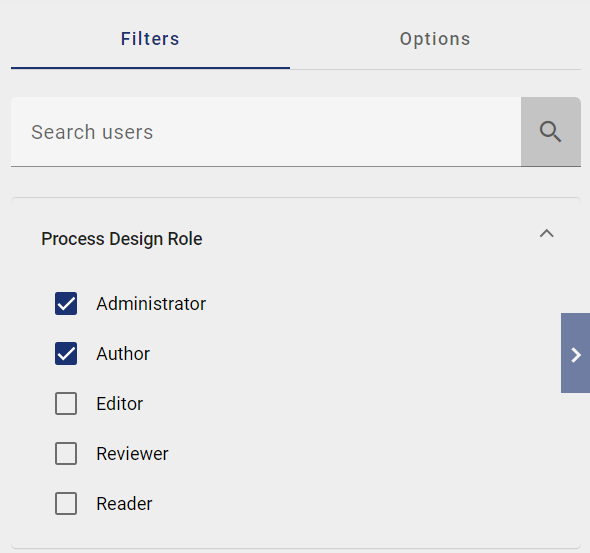
If you have clicked on at least one user role in the Process Design Role filter, all users with the selected user role are automatically displayed in the overview. To return to the original overview of users, click on the previously selected user role again in the Process Design Role filter.
Note
If the user list is already filtered, a new search further reduces the list based on the selected filter options
How do I change the role of a user?
If you are an Administrator and open the Administration menu item in the left menu bar, you will see a collection of predefined tiles. In the Users tile, you have the option to change the role of a user.
If you click on the first tile Users, you will find an overview of all existing users. This overview contains the user name, the BIC Process Design user role, the set user language and the email of the respective users.

By clicking on a user in the list view, you can view, define or change their user details. To change the user role for BIC Process Design, click on the Process Design Role field. To change the user role for BIC Process Execution, click on the Process Execution Role field. This will open the available user roles for that application.
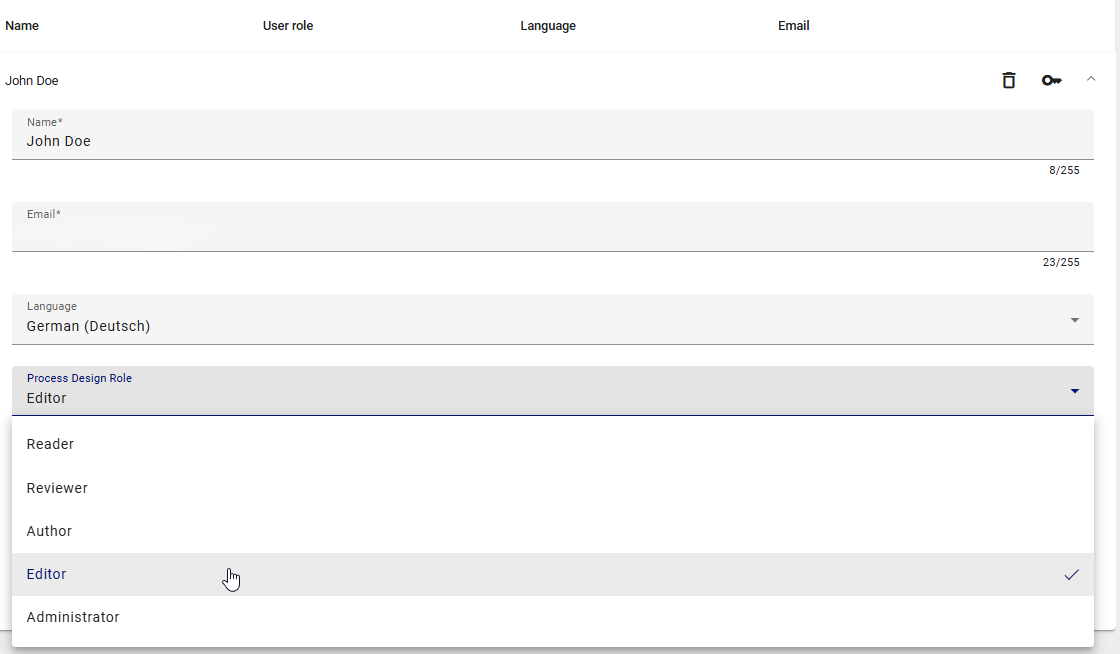
Select the appropriate user role. For BIC Process Design, the user roles Reader, Reviewer, Author, Editor and Administrator are available. For BIC Process Execution, the user roles ProcessApp Participant, ProcessApp User, ProcessApp Creator, ProcessApp Analyst, and ProcessApp Administrator are available, where multiple user roles can be select. The permissions fpr the BIC Process Design and BIC Porcess Execution roles can be found here.
After selecting a BIC Process Design role, you will receive confirmation that your changes have been saved. The user concerned is then automatically informed of the change to their user role by email.
If you have upgraded the rights of a user, he will still be in his old BIC Process Design role at the next login. This ensures that users know their rights. If a user wants to use his new rights, he needs to change his role in the application himself.
Note
If you downgrade the rights of a user, the BIC Process Design role will change immediately.
How do I create a user report?
If you are an Administrator and open the Administration menu item in the left menu bar, you will see a collection of predefined tiles. In the Users tile, you have the option to create a user report.
To create a user report, go to the Options tab in the right sidebar and click the Create user report (Excel) option.
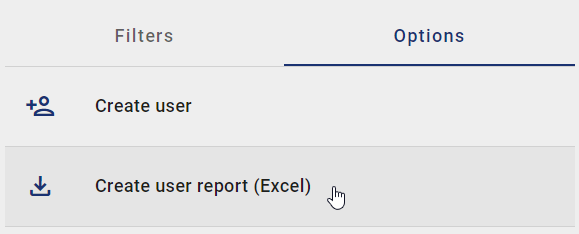
After you have clicked the option, the user report is created. When the creation process is complete, you will receive a message at the bottom right of the screen. This message contains a download link that you can use to download the user report.
The user report is provided in English and contains several spreadsheets about the users and licenses. All the information you see in the overview of the users is also contained in the user report.

How can I assign a user to a person?
Users need to be linked to a catalog entry of the type person, to be able to use them later on for the respecting diagram attributes. The assignment is created via the e-mail address.
Create a person in the catalog or diagram. Enter in the attribute e-mail address exactly the address that the wanted user has in BIC Process Design. Then save your changes.
Alternatively, this catalog entry with the corresponding name and e-mail address is automatically created by selecting a user in attributes, if it does not already exist.
User groups
In addition to role-based authorization, a group-based authorization is also available to facilitate the administration of users in different areas of your company.
Group-based authorization can be used to enable groups of multiple users to model diagrams or objects, or to restrict the access to those diagrams. Further you can use this system to notify user groups about version changes, or to incorporate them directly into the publishing process.
This authorization is possible by assigning user groups to specific diagram- or object attributes. The assignment of user groups works via organizational units.
How can I administrate user groups?
If you are an Administrator and open the Administration menu item in the left menu bar, you will see a collection of predefined tiles. If you click on the User groups tile, you can create and manage user groups.
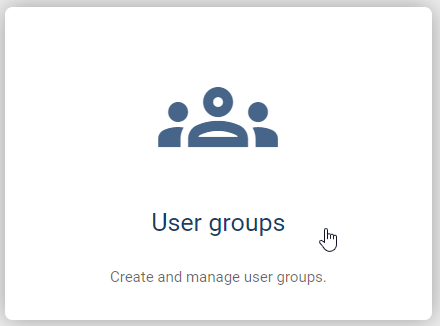
After clicking on the tile, an alphabetically sorted list of all existing user groups will appear. This overview contains the names of all existing user groups. If required, you can rename a user group, delete a user group, add a user to a user group, or remove a user from a user group.
In the right sidebar you will find the Options panel. There you have the option to create a user group. Further information on the respective functions can be found in the linked sections.
Hint
Please note that the functions of the User groups tile are not available in the mobile view.
How can I create a user group?
If you are an Administrator and open the Administration menu item in the left menu bar, you will see a collection of predefined tiles. In the User groups tile, you have the option to create a user group.
To create a user group, click the Create user group button in the Options panel in the right sidebar.
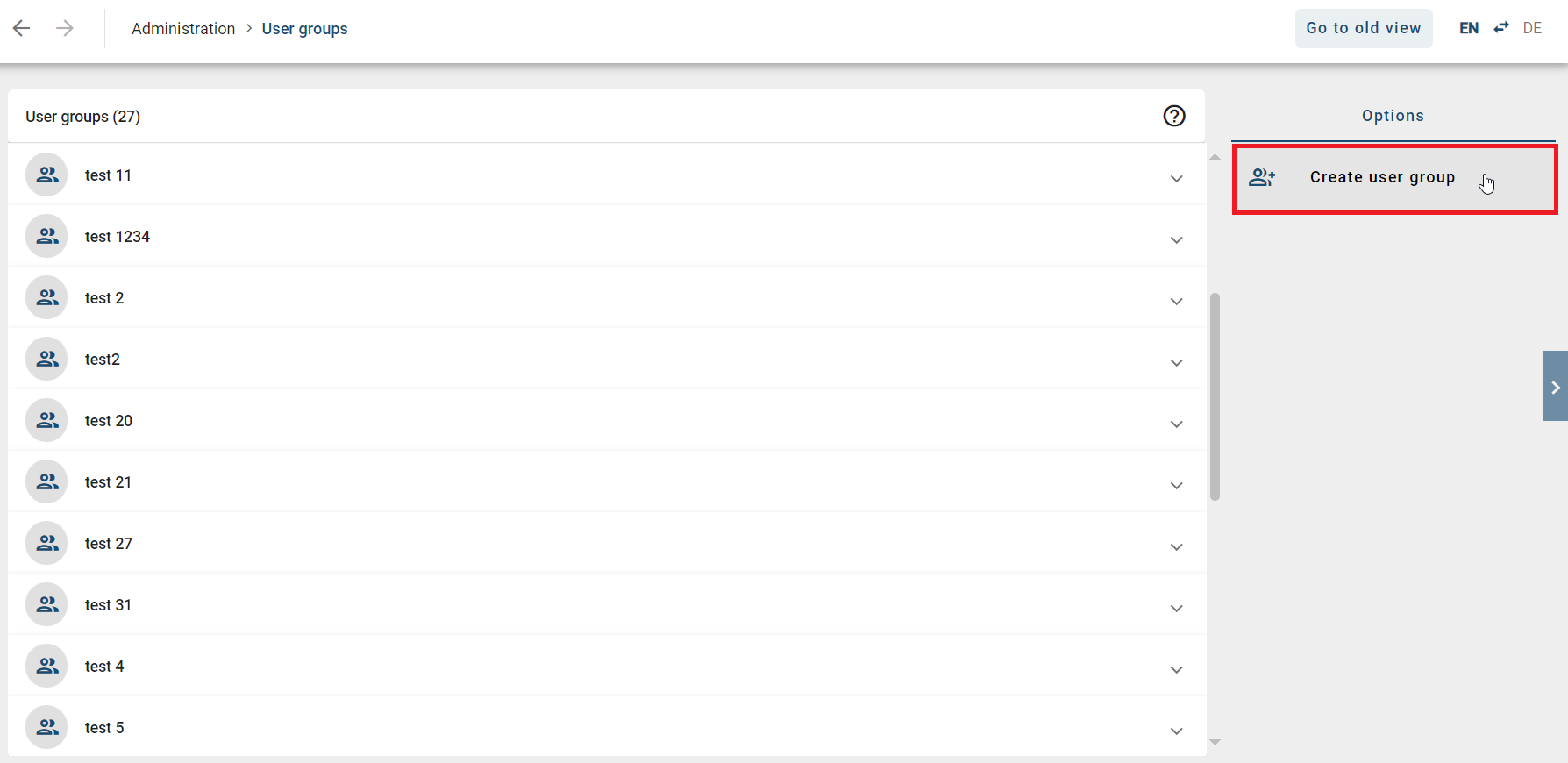
This will open a dialog window where you need to enter the name for the new user group.
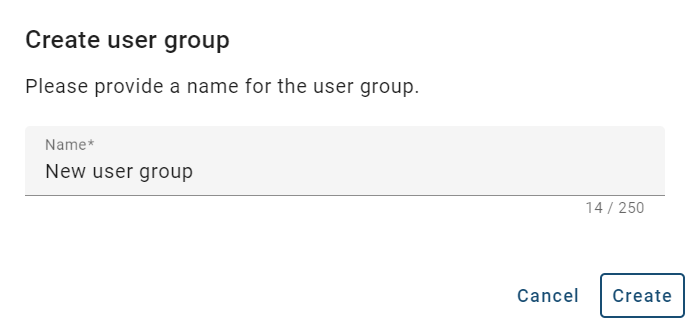
To create a new user group, at least one letter or number must be entered. Only then can you click on the Create button to create the user group. Alternatively, you can click the Cancel button to discard the entry.
The new user group will now appear as the first entry in the list. Upon reloading the page, the user group will be displayed in alphabetical order.
How can I rename a user group?
If you are an Administrator and open the Administration menu item in the left menu bar, you will see a collection of predefined tiles. In the User groups tile, you have the option to rename a user group.
To rename a user group, at least one user group must exist. Click on the desired user group to expand its details. You will then see an input field with the current name of the user group.
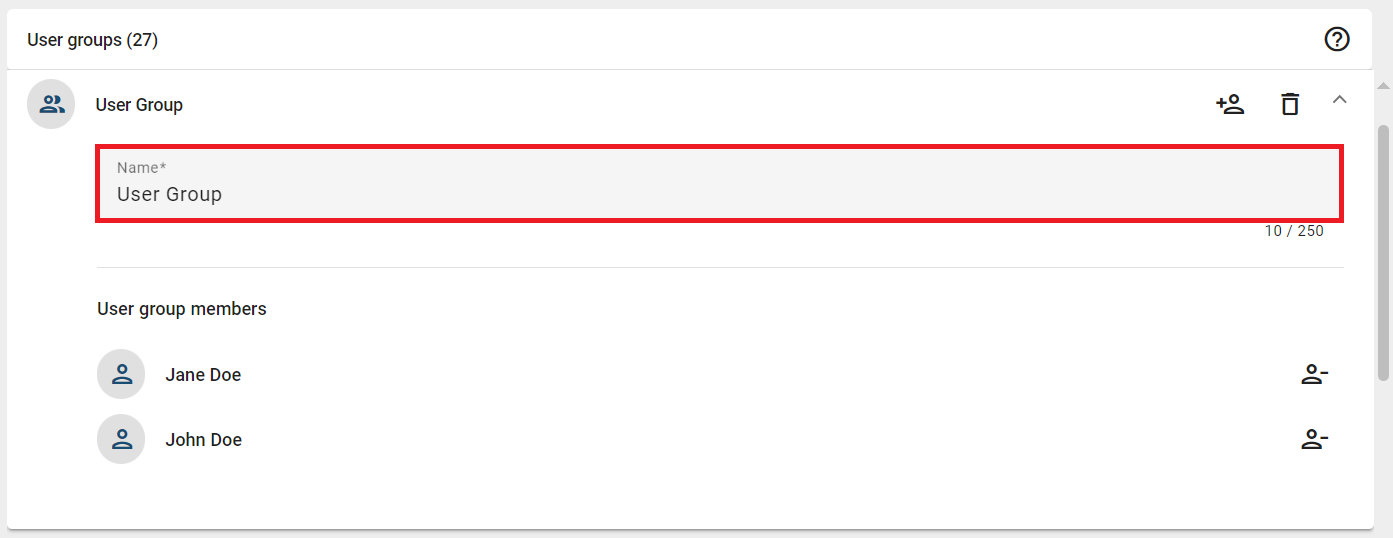
The input field is not read-only, and you can change the name as many times as you want, as long as at least one letter or number is present. Once you add, change, or delete at least one letter or number, your changes are immediately saved and visible to other users.
How can I delete a user group?
If you are an Administrator and open the Administration menu item in the left menu bar, you will see a collection of predefined tiles. In the User groups tile, you have the option to delete an existing user group.
To delete a user group, click on the desired user group in the list to expand its details. You will then see the Delete user group option at the top right.
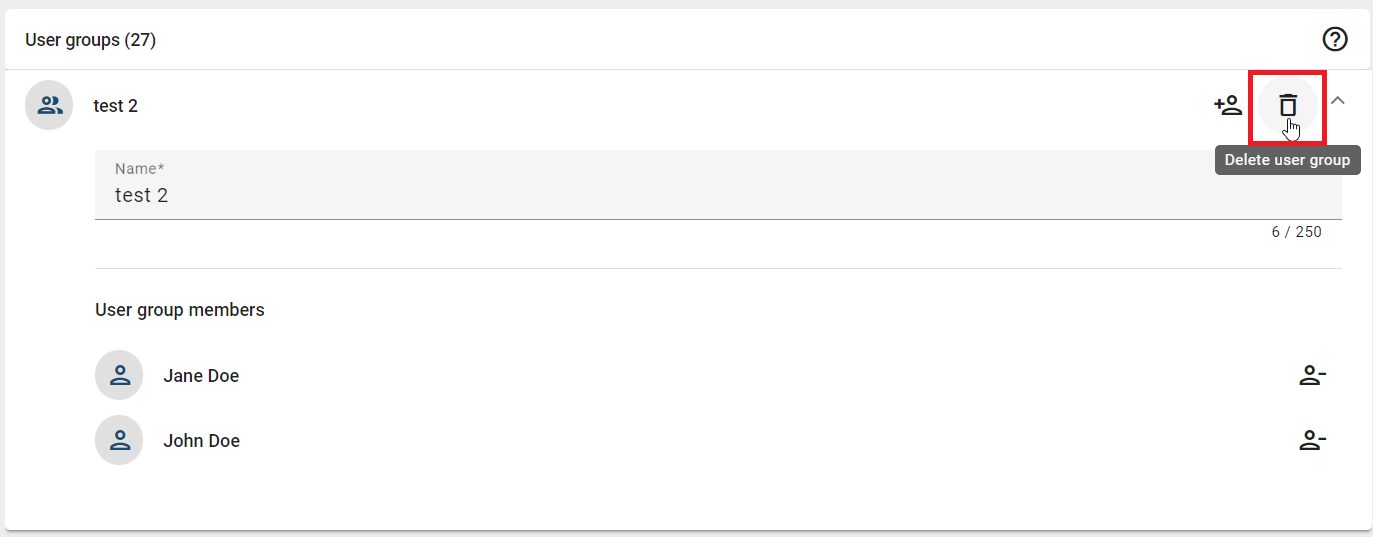
A dialog then opens in which you must confirm the deletion. Click on the Delete button to finally confirm the deletion or on the Cancel button to cancel the deletion.
Subsequently, the user group will be permanently deleted and removed from the list.
How can I add a user to a user group?
If you are an Administrator and open the Administration menu item in the left menu bar, you will see a collection of predefined tiles. In the User groups tile, you have the option to add a user to a user group.
If at least one user group exists, you can add users to it. Click on the desired user group in the list to expand its details. You will then see the option Add users at the top right.
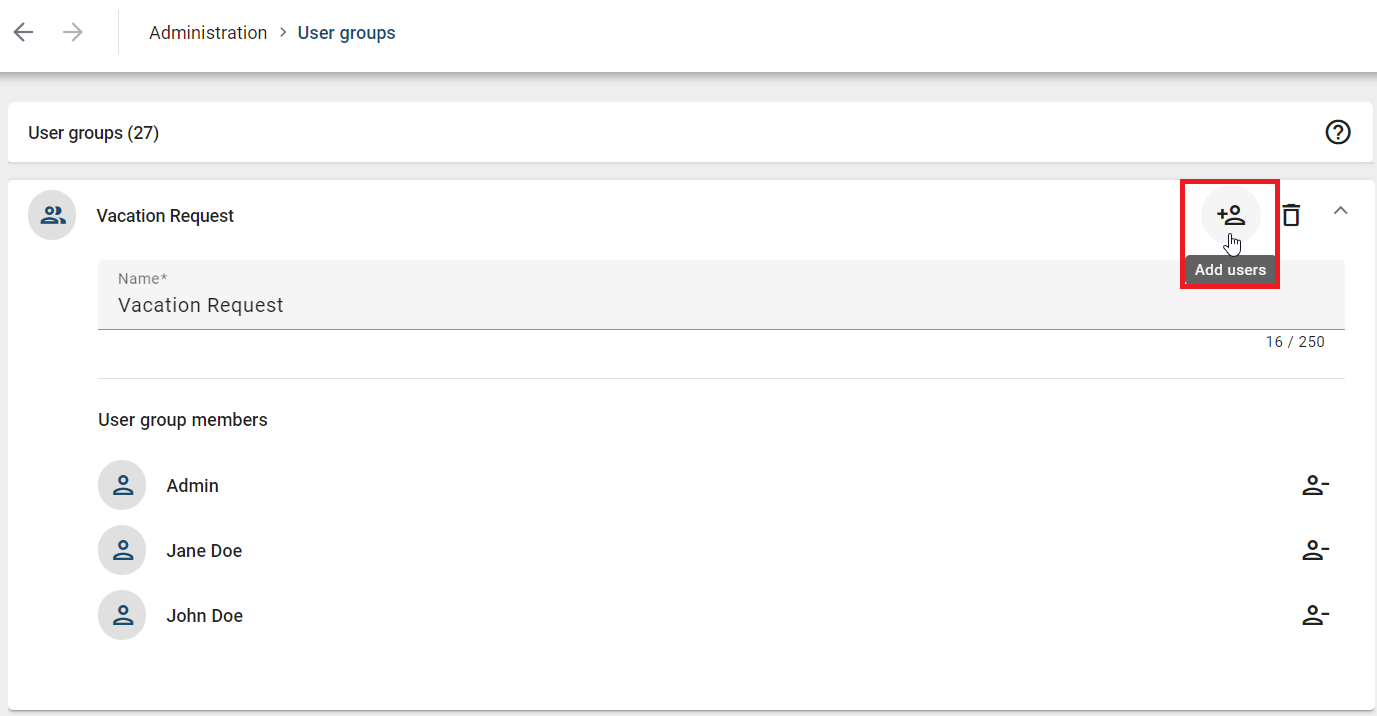
A dialog will then open. There you will see a search field and an alphabetically sorted list of users who are not in the user group. You can search for users in the search field above or use the list of displayed users to select the users you want to add to the user group. The list displays the name, the BIC Process Design user role and the email address of the users.
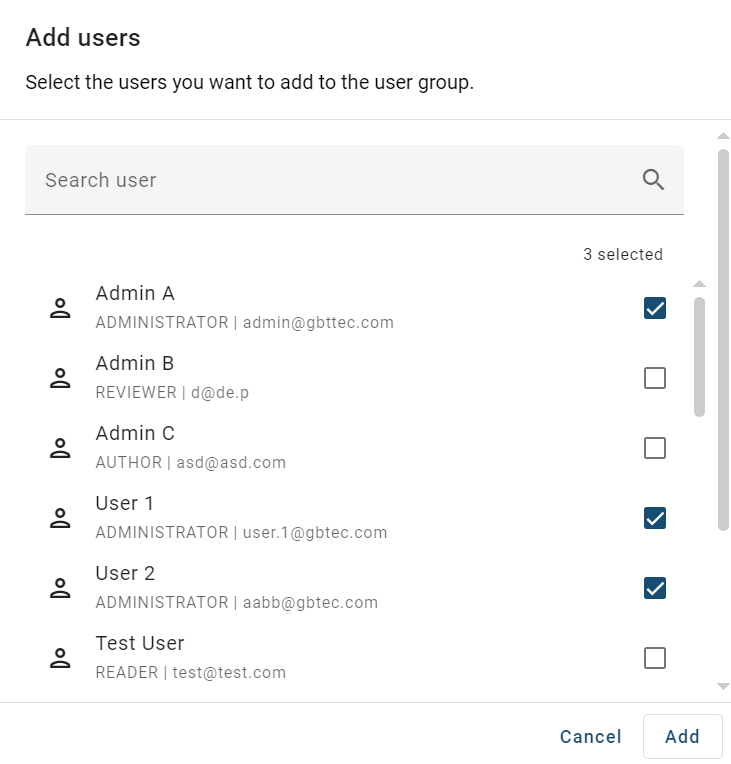
Once you have selected at least one user, you can click on the Add button below to add the users to the user group. To discard the selection, click on the Cancel button.
The newly added users are then displayed in the user group.
How can I remove a user from a user group?
If you are an Administrator and open the Administration menu item in the left menu bar, you will see a collection of predefined tiles. In the User groups tile, you have the option to remove a user from a user group.
If there is at least one user group with at least one user in it, you can remove a user from the user group. Click on the desired user group in the list to expand its details. You can then remove the user by clicking on the Remove user button next to the user’s name.
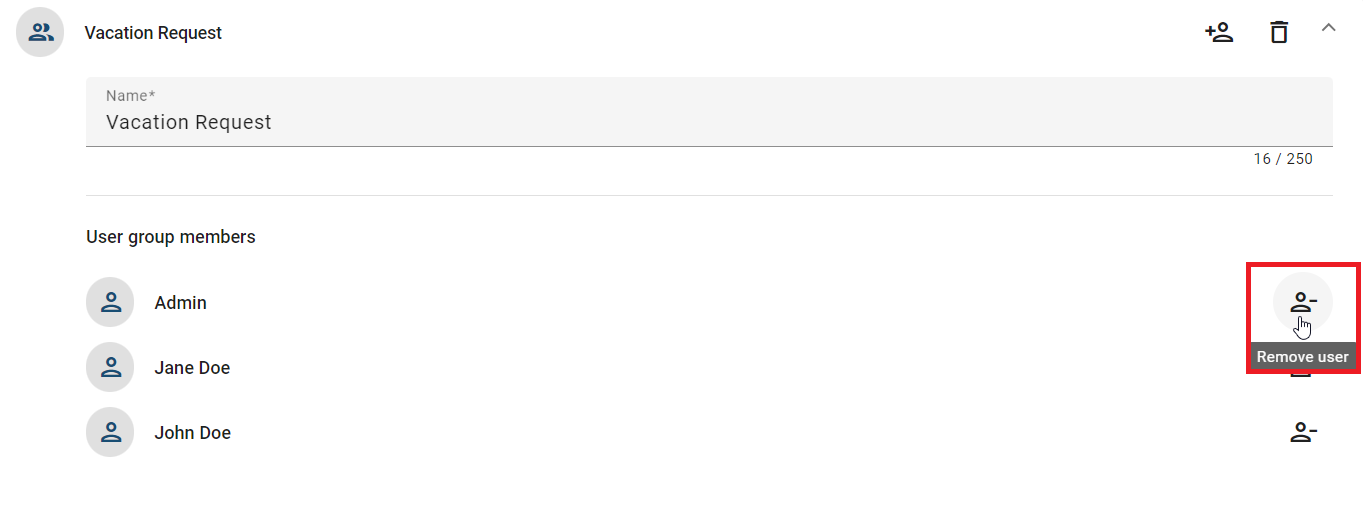
The user is then removed from the user group. If required, you can add users back to the user group.
How can I assign a user group to an organizational unit?
The assignment of a user group to different attributes of a diagram is done via organizational units. Create an organizational unit in the catalog and enter the name of the corresponding user group in the attribute Identifier.
Alternatively, this catalog entry with the corresponding Name and Identifier is automatically created by selecting a user group in attributes, if it does not already exist.
Tip
Give the organizational unit the same name as the assigned user group to clearly recognize it.
Tip
The new user group name can simply be updated in the catalog so that you do not have to change the occurrences manually. Alternatively, it is also possible to create a new group and then replace it.
User logins
How can I analyse the system usage?
If you are an Administrator and open the Administration menu item in the left menu bar, you will see a collection of predefined tiles. The third tile, User logins, will give you an overview of the number of user logins in the last 12 months.
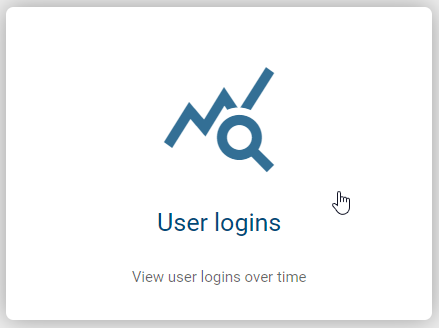
When you click on the tile, a diagram appears that graphically displays the number of user logins over the last 12 months. This visualization of user logins allows you to check how often the application is actually used by a user.
By hovering over the graph, you can see the exact frequency of logins for a particular month.

Hint
The number of logins can be higher than the number of users in a company because every single login of a user is counted. That means that if, for example, a user logs in to the system several times in one day, each login is counted.
Repository
If you are an Administrator and open the Administration menu item in the left menu bar, a collection of predefined tiles will be displayed. By clicking on the fourth tile, Repositories, you will see an overview of all existing repositories and have the option to create, edit, delete, publish, and export new or existing repositories.
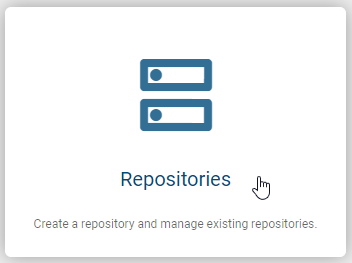
After clicking on the tile, you will see an alphabetically sorted list of all existing repositories in your active language. The alphabetical order of the repositories varies depending on the selected language.
Hint
Please note that the access restrictions set for a repository may prevent navigation to the contents of a repository within the user interfaces. To reliably control access to individual content in a repository, it is recommended that you apply access restrictions specifically to content elements such as diagrams and catalog items.
How can I create a new repository?
If you are an Administrator and open the Administration menu item in the left menu bar, a collection of predefined tiles will be displayed. By clicking on the fourth tile, Repositories, you will see an overview of all existing repositories and have the option to create new repositories.
To create a new repository, click on the Create repository button in the bottom right corner. A dialog will appear in which you must assign a name to the new repository. Once you have entered at least one letter or number, you can click on the Create button. If you select the Cancel option instead, your entry will be discarded and no new repository will be created.
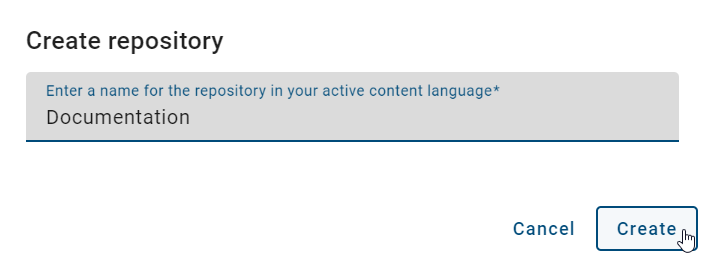
Your new repository will now appear as the first entry in the list in your current language. After refreshing the page, the repository will appear in the correct position in the alphabetical order.
You can now select the new repository from the drop-down menu under Diagrams and Catalog.
How can I edit a repository?
If you are an Administrator and open the Administration menu item in the left menu bar, a collection of predefined tiles will be displayed. By clicking on the fourth tile, Repositories, you will see an overview of all existing repositories and, if at least one repository is available, you will have the option to edit its properties. This includes renaming the repository and adjusting access restrictions.
To edit a repository, click on the corresponding list entry. Alternatively, you can select the Edit properties option in the context menu (three dots) on the right. of the corresponding repository. This opens a dialog where you can make the desired changes.

If you want to restrict access to a repository to specific users, user groups, persons, or organizational units, you can enter the corresponding name in the Access restriction field. This entry is optional and therefore not mandatory.
Then select the Confirm option to apply the changes or discard them by clicking the Cancel button.
Hint
Please note that the access restrictions defined for a repository can prevent navigation to the content of a repository within the user interfaces. In order to reliably control access to individual contents of a repository, it is recommended to apply the access restrictions specifically to the content elements such as diagrams and catalog items.
How can I delete a repository?
If you are an Administrator and open the Administration menu item in the left menu bar, a collection of predefined tiles will be displayed. Click on the fourth tile, Repositories, to see an overview of all existing repositories. If at least one repository is available, you have the option to delete a repository.
To delete an existing repository, open the context menu (three dots) of the corresponding repository on the right and select the Delete option.
A dialog will then appear in which you must enter the name of the repository to be deleted for confirmation. Once you have entered the name correctly, you can click the Delete option. If you want to cancel the deletion process, click on the Cancel option.
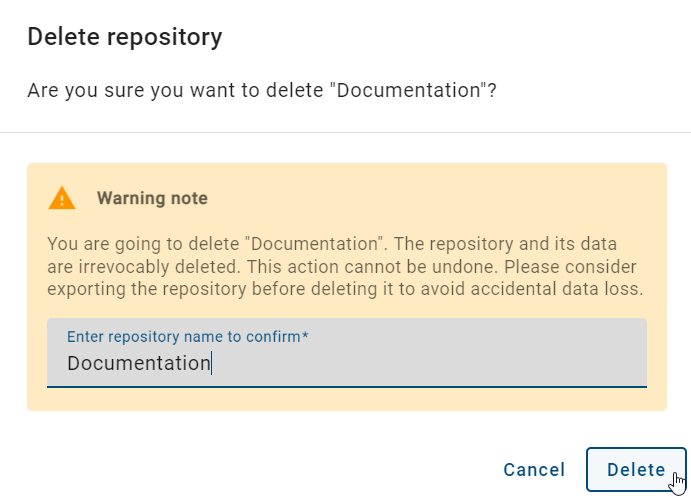
Hint
Please note that the input is case insensitive.
The repository will then be successfully deleted and will no longer be displayed in the list.
How can I publish a repository?
If you are an Administrator and open the Administration menu item in the left menu bar, a collection of predefined tiles will be displayed. Click on the fourth tile, Repositories, to see an overview of all existing repositories. If at least one repository is available, you have the option to publish a repository and make it available for all users.
To publish a repository, go to the Diagrams menu item and click on the context menu next to Repository in the category tree. Select the Publish option.
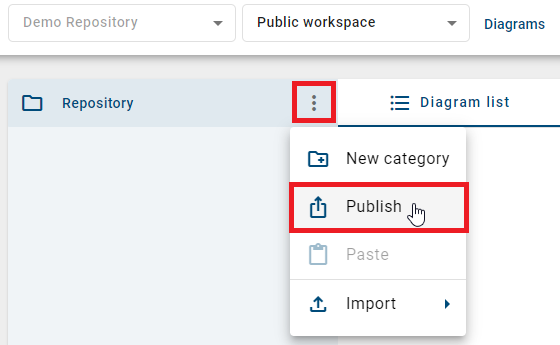
A dialog will appear in which you must enter a comment and the name of the repository to be published.
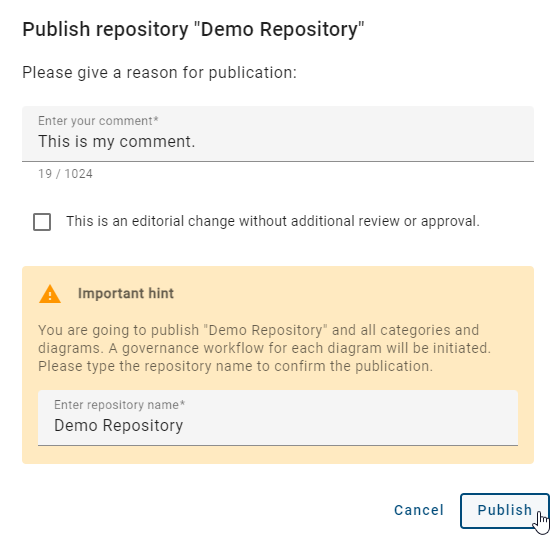
Hint
Please note that the input is case insensitive.
To finally publish your repository, click on the Publish option. Alternatively, you can cancel the process by clicking the Cancel option.
After successful publication, you will receive a notification at the bottom right corner of the screen. If the publication fails, you will receive an appropriate error message.
How can I export a repository?
If you are an Administrator and open the Administration menu item in the left menu bar, a collection of predefined tiles will be displayed. Click on the fourth tile, Repositories, to see an overview of all existing repositories. If at least one repository is available, you have the option to export a repository.
To export a repository, go to the Diagrams menu item and click on the context menu next to Repository in the category tree. Select the Export option.
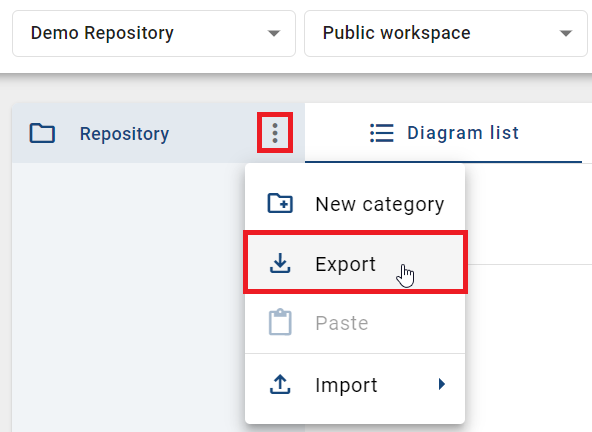
Afterward, a notification will appear at the bottom right corner of the screen, indicating that the export is being created. Once the export is completed, you can download the repository archive using the provided link in the notification.
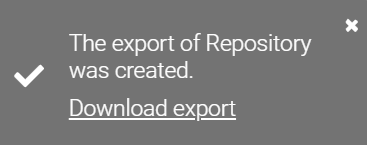
Corporate Design
If you are an Administrator and open the Administration menu item in the left menu bar, you will see a collection of predefined tiles. If you click on the Corporate Design tile, you have the option to adjust the color scheme of the application, upload a company logo, and create a start diagram.
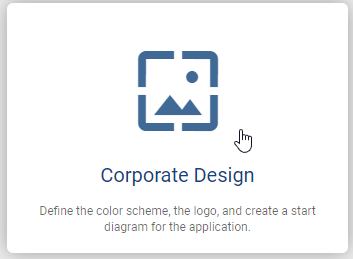
Hint
Please note that the functions of the Corporate Design tile are not available in the mobile view.
How can I adjust the color scheme of the application?
If you are an Administrator and open the Administration menu item in the left menu bar, you will see a collection of predefined tiles. If you click on the Corporate Design tile, you have the option to adjust the color scheme of the application.
After clicking on the tile, you can select the primary color of the application. You may either enter a HEX code manually or pick a color from the palette.
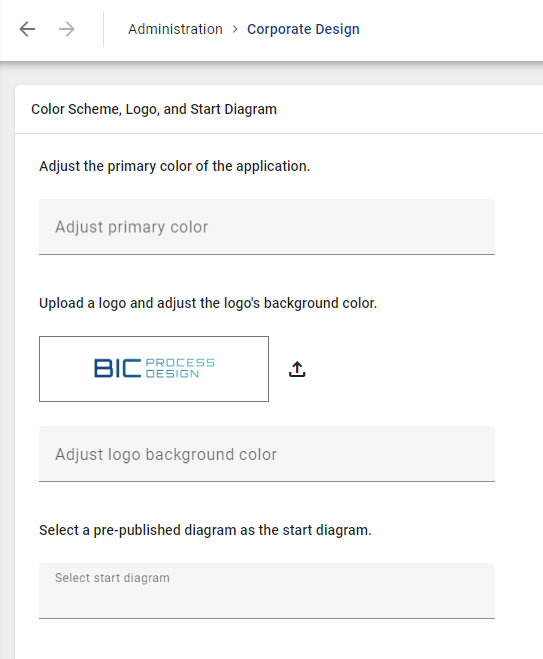
Once you have made at least one change, it will be automatically saved and applied. These changes will be applied to all users after reloading BIC Process Design.
Note
The set color scheme will also be applied for BIC Process Execution.
Hint
Please note that the functions of the Corporate Design tile are not available in the mobile view.
How can I set a company logo?
If you are an Administrator and open the Administration menu item in the left menu bar, you will see a collection of predefined tiles. If you click on the Corporate Design tile, you have the option to set a company logo.
After clicking on the tile, you can click on the button for uploading an image file and select your company logo.
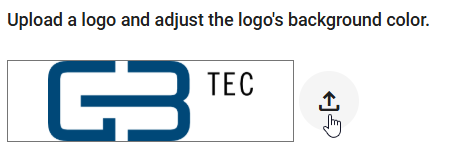
The change is applied to all users after reloading BIC Process Design. The set logo now appears at the top left corner of the page when the left menu bar is expanded.
Note
The company logo set here is also displayed in BIC Process Execution.
Hint
Please note that the functions of the Corporate Design tile are not available in the mobile view.
How can I adjust the background color of the company logo?
If you are an Administrator and open the Administration menu item in the left menu bar, you will see a collection of predefined tiles. If you click on the Corporate Design tile, you have the option to adjust the background color of your company logo.
After clicking on the tile, you can select the background color for the logo located below your logo. When selecting a color, you can either enter a HEX code manually or choose a color from the color palette.
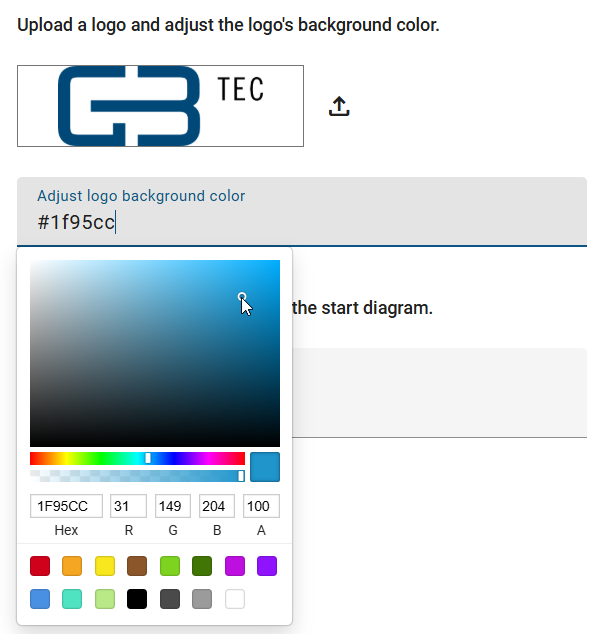
The changes will be applied to all users after reloading BIC Process Design. If a transparent logo is used, the background color will be visible in the top left corner of the page when the left menu bar is expanded.
Hint
Please note that the functions of the Corporate Design tile are not available in the mobile view.
How can I set a company-wide start diagram?
If you are an Administrator and open the Administration menu item in the left menu bar, you will see a collection of predefined tiles. If you click on the Corporate Design tile, you have the option to set a company-wide start diagram.
After clicking on the tile, you can select a published diagram in the Select start diagram input field. Enter the name of the desired diagram in the input field and select if from the list of suggestions.

After reloading BIC Process Design, the set start diagram is displayed for all users on the myBIC page.
Hint
You can only set one start diagram. You can adjust the start diagram at any time if needed.
Hint
Please note that the functions of the Corporate Design tile are not available in the mobile view.
Catalog
If you are an Administrator and open the Administration menu item in the left menu bar, you will see a collection of predefined tiles. If you click on the Catalog tile, you have the option to edit catalog object types and set attributes as filters for them.
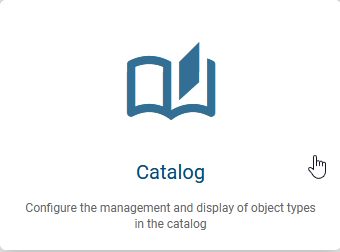
Hint
Please note that the functions of the Catalog tile are not available in the mobile view.
How can I edit the details of catalog object types?
If you are an Administrator and open the Administration menu item in the left menu bar, you will see a collection of predefined tiles. If you click on the Catalog tile, you have the option to edit catalog object types.
Once you have clicked on the tile, you will be directed to the details page by default, where all object types are listed in alphabetical order according to the browser language. Each entry in the list shows the name and symbol of the object type.
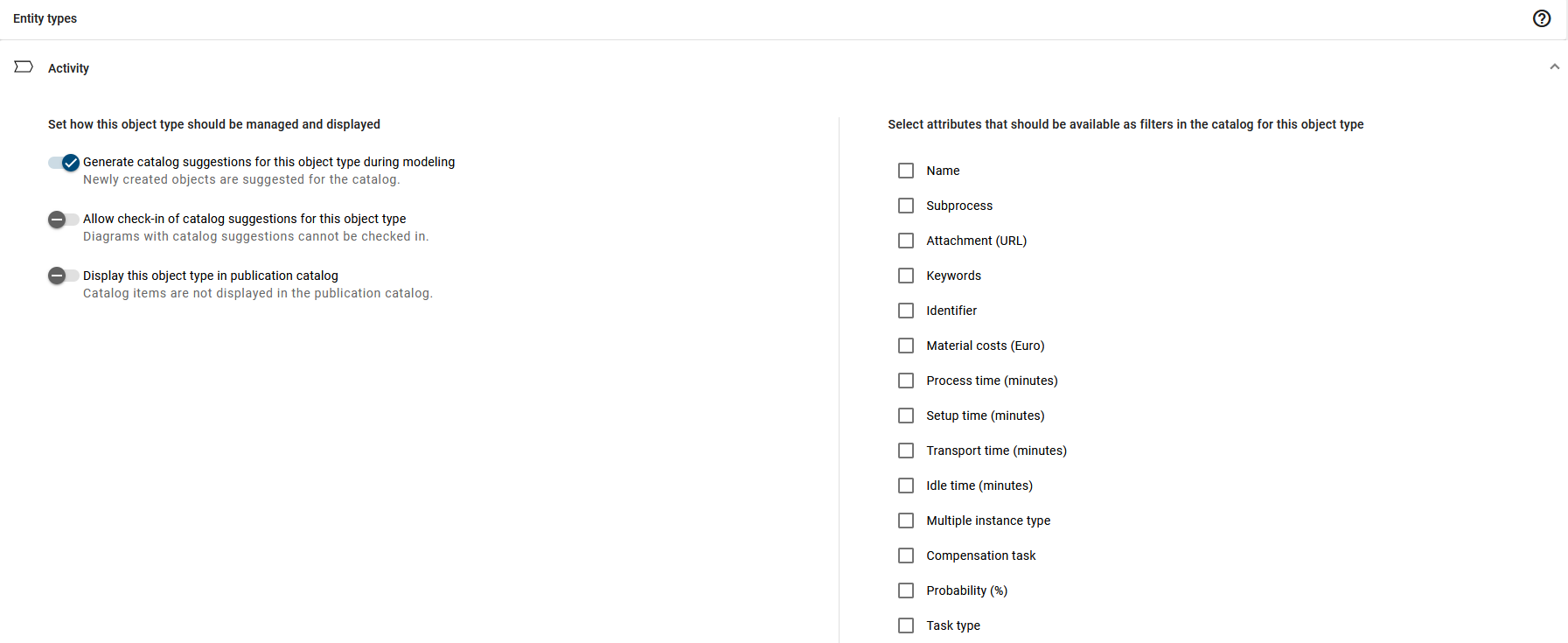
If you click on an entry in the list, you will be taken to the object type settings, where you can make various settings for the respective object type.
Hint
Please note that the functions of the Catalog tile are not available in the mobile view.
How can I define whether catalog suggestions are generated automatically during modeling?
If you are an Administrator and open the Administration menu item in the left menu bar, you will see a collection of predefined tiles. If you click on the Catalog tile, you have the option to define whether catalog suggestions are generated automatically during modeling.
Once you have clicked on the tile, you will be directed by default to the details page, where all object types are listed alphabetically based on the browser language. Clicking on an entry in the list will take you to the settings for that object type.
Here you can click the toggle switch next to Generate catalog suggestions for this object type during modeling to define whether catalog suggestions should be generated automatically during modeling. The selected behavior only applies to newly created objects and is displayed as a subtitle of the button.

For example, if you deactivate the “Application” catalog object, applications will no longer be displayed as a suggestions in the catalog during modeling. However, you can still manually create them in the catalog and reuse them in the diagram.
Hint
Please note that the functions of the Catalog tile are not available in the mobile view.
How can I define that diagrams can only be checked in with existing catalog objects of a type?
If you are an Administrator and open the Administration menu item in the left menu bar, you will see a collection of predefined tiles. If you click on the Catalog tile, you have the option to define that diagrams can only be checked in with existing catalog objects of a type.
Once you have clicked on the tile, you will be directed to the details page by default, where all object types are listed in alphabetical order according to the browser language. If you click on an entry in the list, you will be taken to the object type settings.
Here, you can use the toggle switch next to Allow check-in of catalog suggestions for this object type to specify whether diagrams can only be checked in with existing catalog objects of that type. The selected setting is displayed as a subtitle below the switch.

If the switch is deactivated, diagrams with non-existing catalog objects cannot be checked in. This ensures that only existing objects are used for modeling, thus preventing redundancies.
Hint
To perform validation, the “Generate catalog suggestions for this object type during modeling” option should be enabled.
Hint
Please note that the functions of the Catalog tile are not available in the mobile view.
How can I define that catalog objects are displayed in the publication?
If you are an Administrator and open the Administration menu item in the left menu bar, you will see a collection of predefined tiles. If you click on the Catalog tile, you have the option to define that catalog objects are displayed in the Publication stage.
Once you have clicked on the tile, you will be directed to the details page by default, where all object types are listed in alphabetical order according to the browser language. If you click on an entry in the list, you will be taken to the object type settings.
Here you can click the toggle switch next to Display this object type in publication catalog to define whether the selected catalog object is allowed to be displayed in the publication. The selected behavior is displayed as a subtitle of the button.

Hint
Please note that the functions of the Catalog tile are not available in the mobile view.
How can I set filters for specific catalog object types?
If you are an Administrator and open the Administration menu item in the left menu bar, you will see a collection of predefined tiles. If you click on the Catalog tile, you have the option to select attributes for specific catalog object types. Once selected, they are available as filters for that object type. To do this, select an object type from the list and click the Filter tab next to the Governance tab.
You can then select all available attributes from a drop-down list, which are automatically enabled upon selection and are available as filters for that object type. To remove attributes as filters, click the attribute in the drop-down list again.
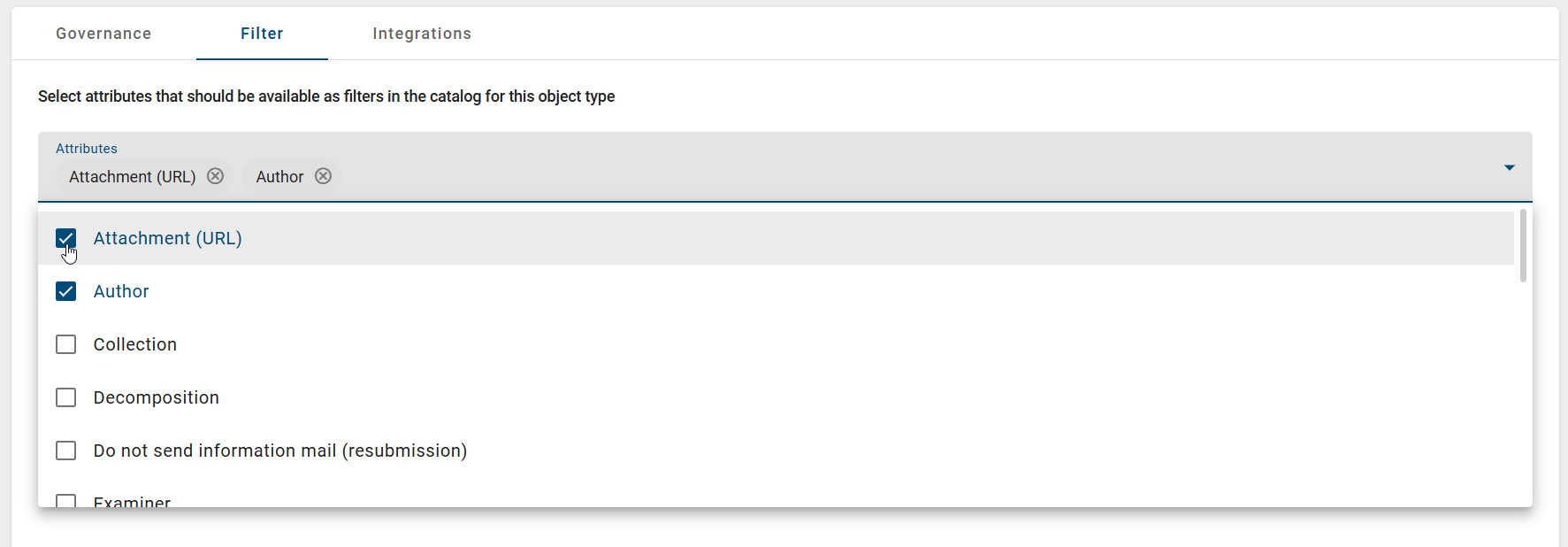
Note
A maximum of 127 facets can be selected for a catalog object type. The facets are displayed according to the selected attributes.
Hint
Please note that the functions of the Catalog tile are not available in the mobile view.
Integrations
How can I integrate websites into a new tab in the catalog for a specific catalog object type?
As an Administrator, you have the option to integrate websites into a new tab in the catalog for specific catalog object types. This allows you to integrate content from other websites into BIC without being redirected to another website as a user. Additionally, integrations can be used to reference other content within BIC. To do this, go to the Administration menu item in the left menu bar and click on the Catalog tile. You will see a list of all available catalog object types.
After selecting a catalog object type, you will see the Integrations tab next to the Filter tab. Here, you can configure so-called integrations that will be displayed as a separate tab in the catalog for the selected object type. To configure an integration, click the Create integration button at the bottom right of the screen.
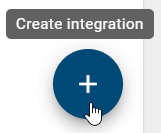
This opens a dialog where you need to enter a URL and a title for the integration. Entering the title in your default language is mandatory. Providing the title in additional languages is optional. You can also optionally add user groups or repositories that should have access to the integration in the catalog. If you do not add any user groups, all users will have access to the integration.
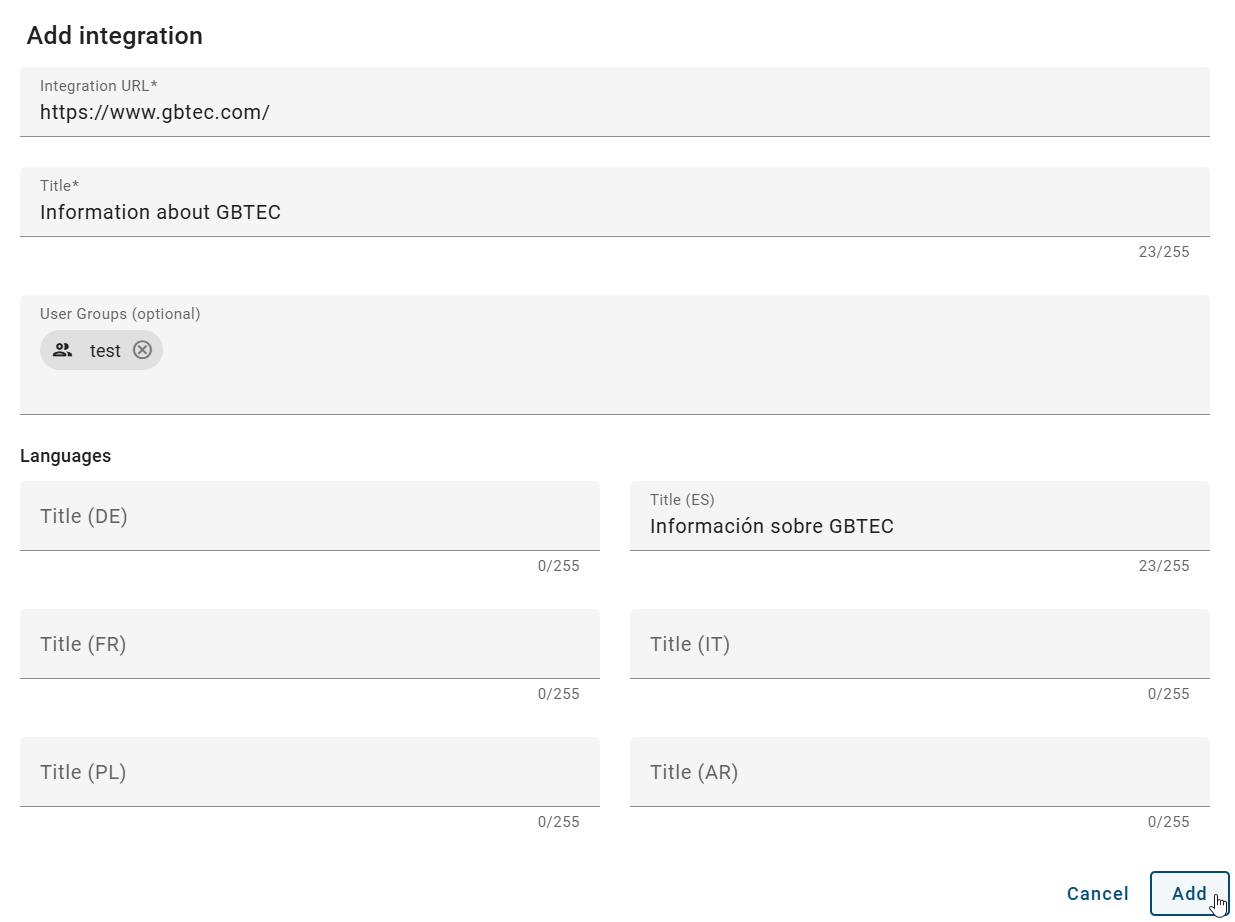
You also have the option of adding one or more repositories in the corresponding dialog when creating or editing an integration. An additional field is displayed in the dialog in which you can select or enter the desired repositories. If exactly one repository is stored, its name is displayed. If several repositories are assigned, the number of repositories is displayed instead. If no repository has been defined, the field remains empty.
As soon as at least one repository has been added, the Integration tab is displayed in the catalog if you are in one of the stored repositories. You can access this tab using the left sidebar in the catalog. The integration is displayed there as a separate tab with the name that you have previously defined in the Administration area.
Note
Please note that the Integration tab is only displayed if you belong to one of the user groups defined for the integration or if no user groups have been defined. You must also be in a repository that has been released for the integration or no repository has been defined. If these requirements are not met, the tab is hidden in the catalog.
Note
The title and foreign language titles are limited to 255 characters. The number of user groups is limited to 100.
When you create or edit an integration as an administrator, you can use specific placeholders in the URL field. The placeholders {{tenantId}}, {{repositoryId}}, {{stage}}, {{language}} are automatically replaced with the appropriate values when the integration is later executed. For example, if you enter the URL example.com/tenants/{{tenantId}}, the variable {{tenantId}} will automatically be replaced with the ID of the currently selected tenant when this integration is opened in the catalog. The placeholder then becomes something like //example.com/tenants/123. This allows you to dynamically link to tenant-specific, language-specific, or other context-sensitive content.
Once you have entered at least the URL and a title for the integration, you can add it by clicking the Add button. The integration will then appear in the Administration in the Integrations tab for the selected catalog object type.
The integration will also appear as a new tab in the catalog, displayed in content language, when you filter by the selected catalog object type. If your content language is not maintained, the integration will be displayed in your default language.

Hint
Please note that the use of integrations requires a separate licence, which you must purchase.
Note
If you enter a URL to a published ProcessApp in the “Integration URL” input field, no new tab will be created. Instead, for catalog objects of the selected type, an additional option will be displayed in the Options panel that allows you start a new case for the linked ProcessApp.
How can I delete an integration?
When you open the Catalog tile in the Administration as an Administrator, you will see the Integrations tab after selecting a catalog object type. A list of already configured integrations is displayed here, if any have been configured for this catalog object type.
To delete an integration, select the integration and open the context menu. When you click the Delete button, a hint appears stating that the deletion is final and cannot be undone. Click the Delete button again to remove the integration for the selected catalog object type.

The list of remaining integrations is then updated automatically.
Hint
Please note that the use of integrations requires a separate licence, which you must purchase.
How can I edit an existing integration?
If you open the Catalog tile in Administration as an Administrator, you will see the Integrations tab after selecting a catalog object type. Here you will see a list of the already configured integrations, if any have been configured for this catalog object type.
To edit an integration, select an integration and open its context menu. When you click the Edit button, a dialog opens. This shows the current data and allows you to make and save changes.

As soon as the dialog for an existing integration is opened, all mandatory fields (Integrations-URL and TItle) must be filled in when editing. Only then can you click the Save button, which accepts the entered data and updates the list of integrations. If not all mandatory fields are filled in, the Save button will remain deactivated to prevent an incomplete integration.

Hint
Please note that the use of integrations requires a separate license and must be purchased by you.
Languages
How can I define languages for my users?
In the tile Languages, you can set the default languages as well as additional content and alternate languages for your users.
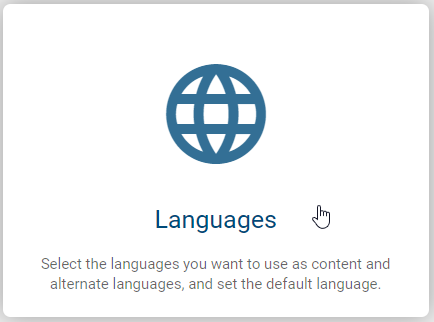
After clicking on the tile, an alphabetically sorted list of all languages supported by BIC will appear. By clicking on a selected language, you can define the content and alternate languages. To set a language as the default, click on the Web icon within the language entry. The default language is the language that is automatically displayed after logging in.

Hint
Please note that the functions of the Languages tile are not available in the mobile view.
Hint
Please note that when switching to the alternative language, process names, descriptions and forms are displayed in this language if a translation is available. Otherwise, the content remains in the original content language. The user interface and system messages remain unchanged and continue to be displayed in your browser language.
Archive
In the Archive tile, you can configure the settings for the archive and define the access permission for Reader.
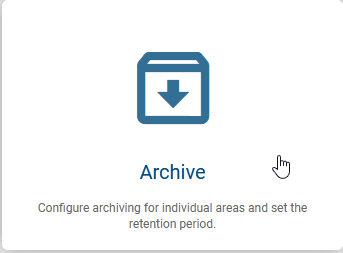
Hint
Please note that the functions of the Archive tile are not available in the mobile view.
How can I change archive settings?
As an administrator, you have the option of customizing the settings for the archive in the Public workspace, Preview, and Publication areas across all diagrams. In addition to activating or deactivating the archive, it is also possible to configure the retention period individually.
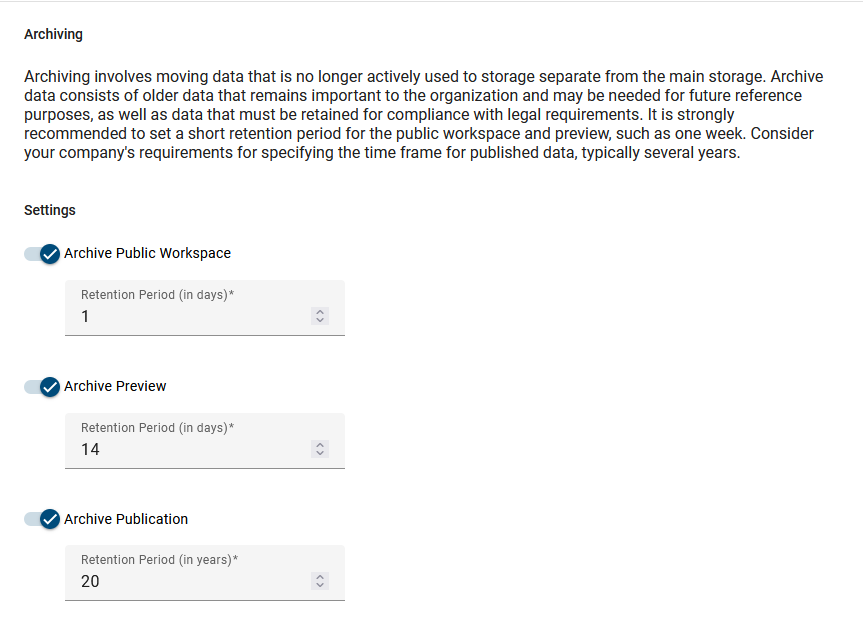
The archiving status can be activated or deactivated using the toggle switch. If you activate archiving, the input field becomes active and can be edited. If archiving is deactivated, the input field remains locked, and the corresponding value is displayed in read mode.
If archiving is activated, you can use the input field to change the retention period as required. Any changes are saved immediately, and a notification of the successful changes appears at the bottom right-hand side of the screen.
How can I set access permission for Reader?
In the archiving settings, you can set access permissions to archives for the Reader user role. If you have disabled access, Reader cannot access or compare archived versions of diagrams and objects in the publication.
To set access permissions, scroll down to the bottom of the archiving settings and toggle the switch under Access.

Method
In the Method tile, you can manage your methods, customize the colors of the symbol types and configure the diagram layout.
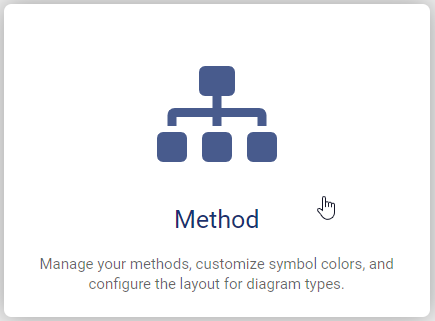
Hint
Please note that the functions of the Method tile are not available in the mobile view.
How can I import a method?
When you open the Method tile, you will find the Options in the right sidebar. To import a method, click on Import.
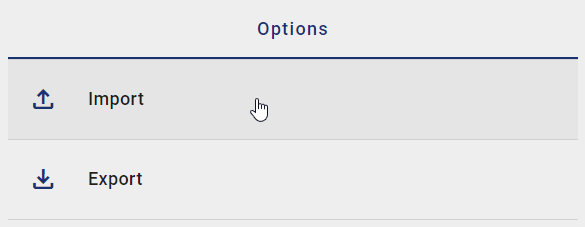
You can then select and import a JSON file from your local storage.
If the import was successful, you will receive a corresponding message and can view the current method in the read-only field.

How can I export a method?
When you open the Method tile, you will find the Options in the right sidebar. To export your current method, click on Export.
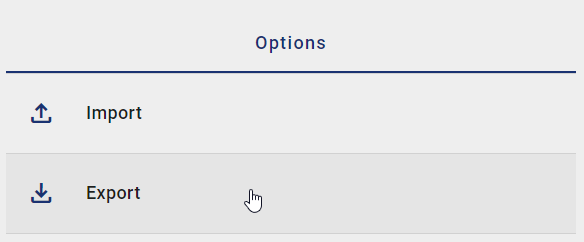
The current method will be exported directly as a JSON file.
How can I configure the standard colors of the symbols?
You have the option to set the color scheme of a symbol type to a personal standard for all stages of your BIC Process Design. Diagrams from the archive will always be displayed with the current color settings. For each symbol type, you can set the border, background, and font color.
Warning
Please note that the colors you choose here will affect all stages, including diagrams in publication. Also, please consider the notes on configuring certain symbol types.
If you are an Administrator and open the Administration menu item in the left menu bar, you will see a collection of predefined tiles. In the Method tile, you have the option to adjust the method file, change the default color of the symbol types, and set the layout of the diagram types.
After clicking the Method tile, navigate to the Symbol types tab. Here, you will find a list of all configurable symbol types in your current method. The Default column next to each symbol type indicates whether it is set as the default for the corresponding object type. If the checkbox is selected, the symbol is defined as the default. To adjust the color of a symbol type, simply select it.
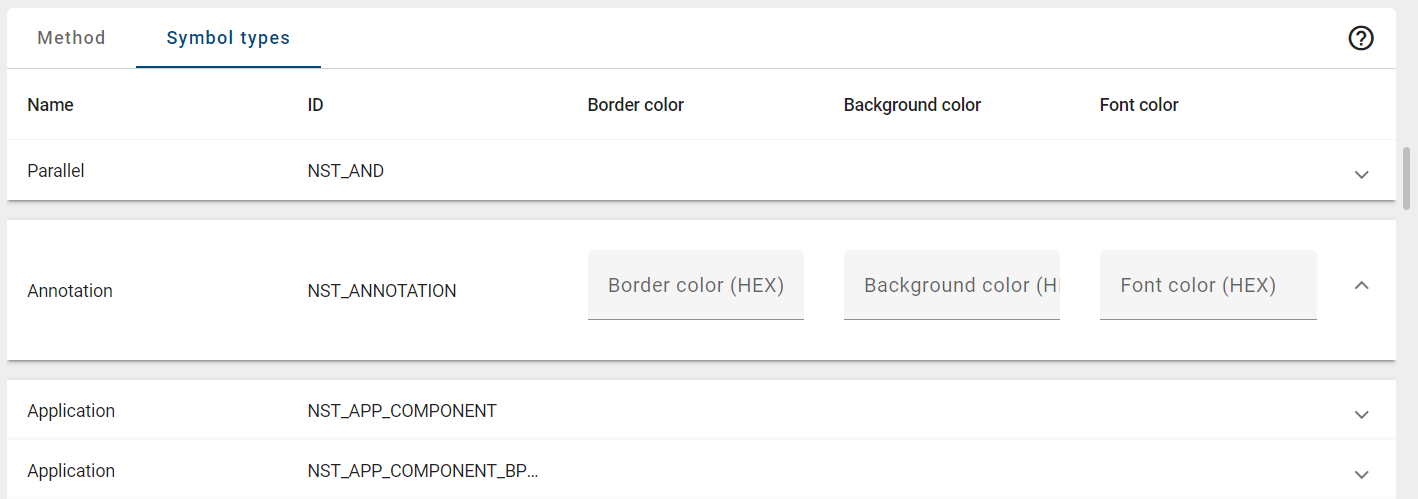
Once you have clicked on a symbol type, click on the corresponding color field that you want to adjust. You can select a color value from the color palette or enter a HEX code.
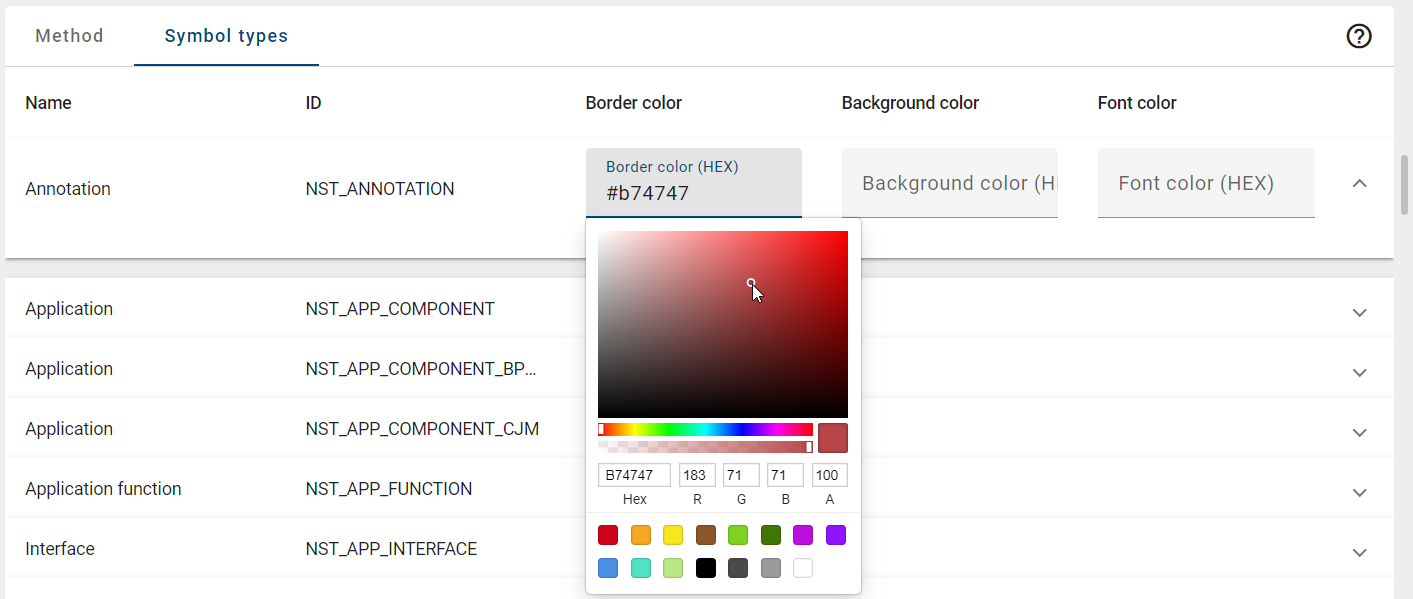
Note
Please note that the color specified in the Border color column is also used for coloring the corresponding object type in various areas of the application, including the catalog list, search, and attributes.
Note
Please note that if no color is set, the symbol will be displayed in BIC Process Design’s default color. If you have set a color value and want to return to the default color, please clear the input field.
After configuring the symbol type colors, select the Mass application option in the Options panel in the right sidebar. This will open a dialog where you need to confirm your changes.
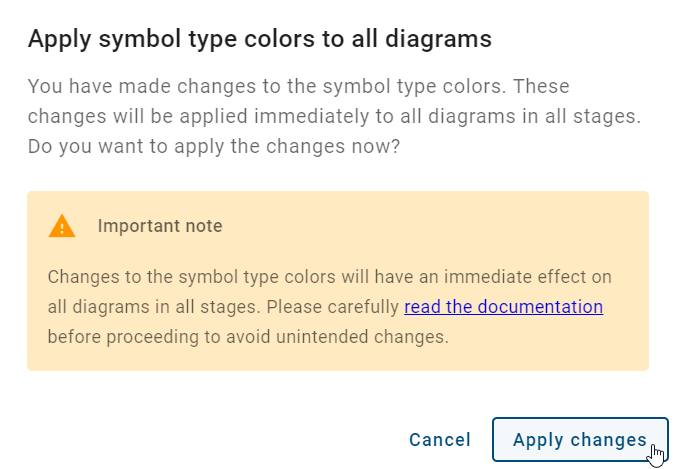
To apply your color changes to all diagrams in all stages, click on the Apply changes button. To cancel the process, click on the Cancel button.
Your changes will then be visible in all diagrams after a refresh.
Note
It is also possible to format individual symbols using the symbol palette. The color formatting done there will be applied to all stages and will not be overwritten by later changes to the general color configuration explained here.
How can I import or export symbol colors?
You can import and export your own color settings for symbol types. This allows you to switch between different symbol colors.
Hint
Please note that changing the symbol colors will affect all diagrams in all stages.
To import or export your symbol type colors, open the Method tile and navigate to the Symbol types tab. In the right sidebar, you will find the respective options.
Import:
If you have edited your symbol type color settings externally or want to re-upload and use previous versions, select the Import option.
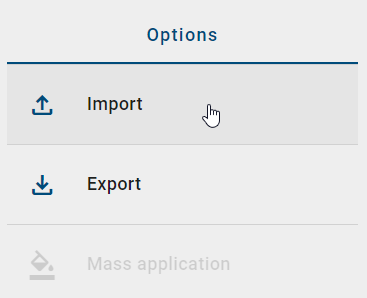
Select a JSON file and click on the Mass application option to apply the color settings.
Warning
Please note that if you upload your own JSON file, all symbol IDs you use in it must be correct and present in your method. If you use symbol types that are not present in the currently used method, this may result in unexpected behavior.
Export:
To export your current color settings as a JSON file, click on Export.
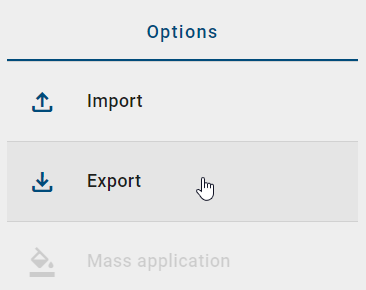
How can I set the layout of a diagram type?
The layout assistant is designed to assist you in arranging the process flow, focusing on sequence flow and activities. You can configure and customize the EPK, WKD, and BPMN diagram types by default.
When you open the Method tile, navigate to the Diagram layout tab. On the right sidebar, you will find a list of the available diagram types and their corresponding diagram IDs. To edit the layout of a diagram, click on a diagram type.
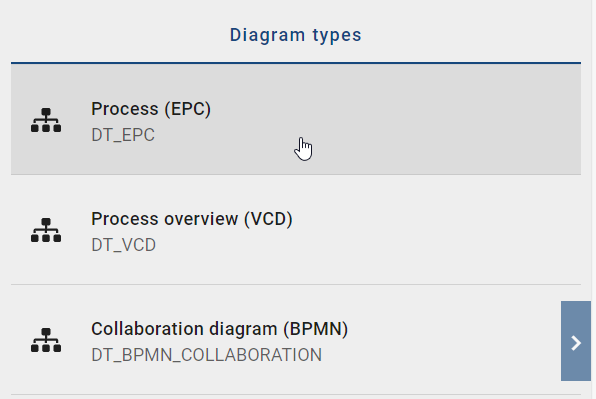
In the main section, you will find the settings for the selected diagram type, which are described in detail below:
Modeling orientation: Here, you can choose between Horizontal and Vertical to determine the alignment of the layout assistant. The direction refers to the process flow, represented by, for example, sequence and message edges between activities.
Horizontal/Vertical distance (cm): This defines the distance in the process flow by entering numbers. It represents the horizontal and vertical distance in centimeters between two symbols connected by a sequence or message edge.
Horizontal/Vertical satellite distance (cm): This input defines the horizontal and vertical distance between satellites in centimeters.
Satellite positioning: To set the position of satellites, click on the corresponding quadrant and edit the input field. Specify which object type with which relationship to the activity should be automatically placed here during layouting. You can also set the maximum number of symbols arranged vertically above each other. If the number exceeds during layouting, a new column of vertical arrangement will be created. Once you’ve saved your input by pressing the Enter key, it will be displayed as a chip in the quadrant. If needed, you can remove the chip by clicking on the quadrant.
Quadrant Ports: Quadrant ports correspond to the edge ports of the satellites of an activity. By clicking on a quadrant, you can choose between two selectable ports - Horizontal and Vertical. Your selection is saved immediately.
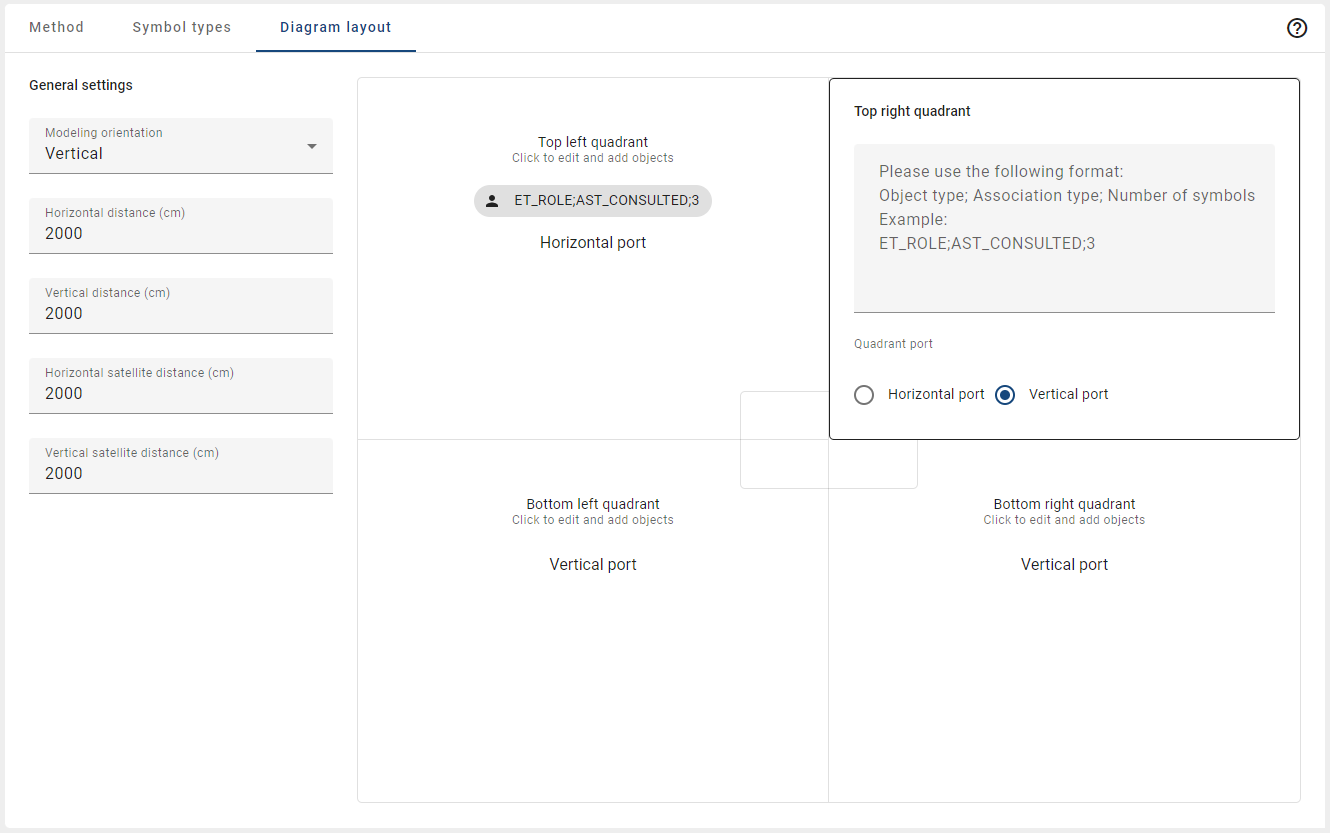
The default settings defined for the layout assistant will be overridden with this configuration. If no individual behavior is defined, the layout assistant uses the default.
Note
Chips can only be generated for object types that exist in the method. There is no further validation of your input. Note the existing object types and association types.
Search
How can I select attributes as search facets?
In the Search tile, you can select attributes as search facets to set filters for the central search and the list of diagrams.
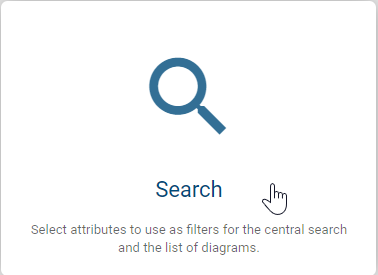
Click on the Search tile to access the details page. The alphabetically sorted list displays all attribute types from the current method.
By clicking on an attribute, you can activate or deactivate it. As an administrator, you have the option to remove an attribute type as a search filter or save an unselected attribute type as a search filter.
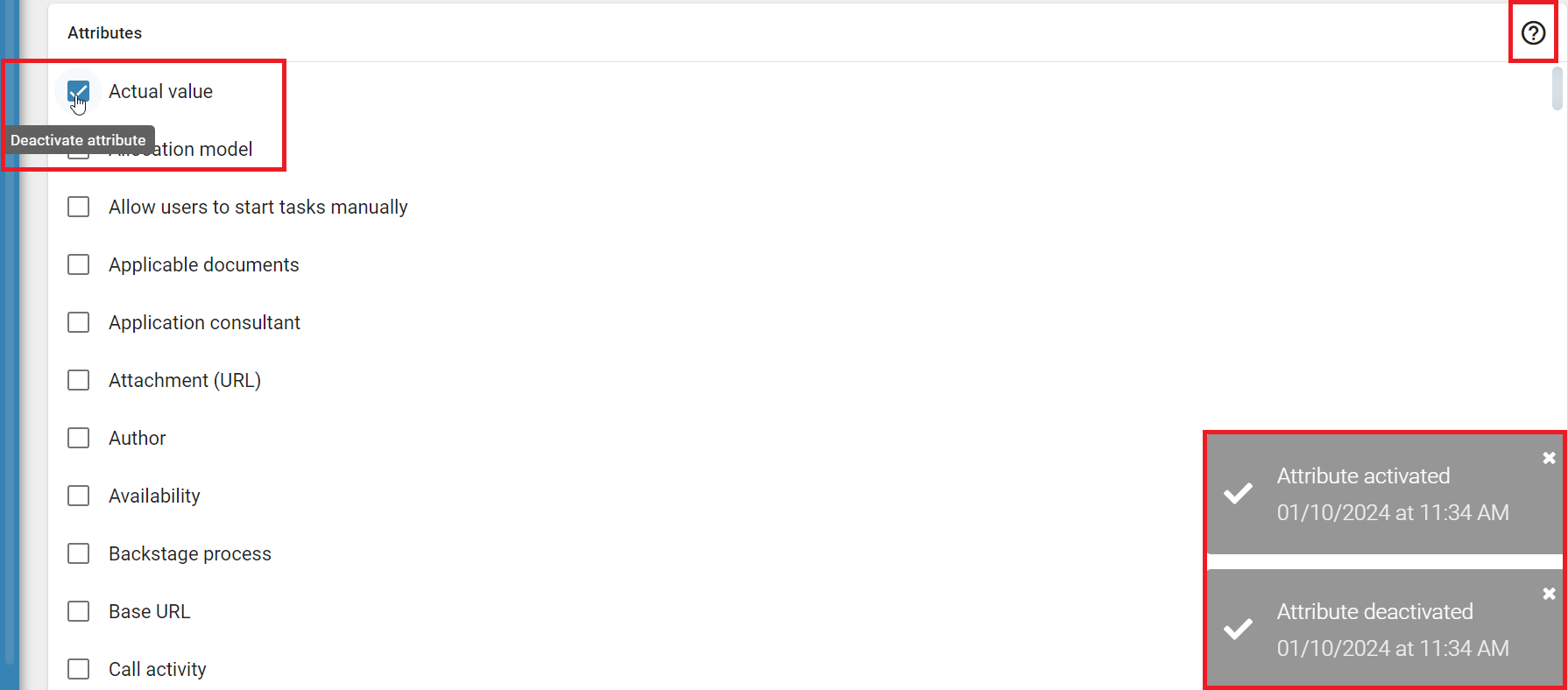
Hint
Please note that the functions of the Search tile are not available in the mobile view.
Workflows
How can I set the validation scope for language-dependent mandatory attributes?
In the Workflows tile, you can configure the validation scope for mandatory attributes to specify the languages to be checked.
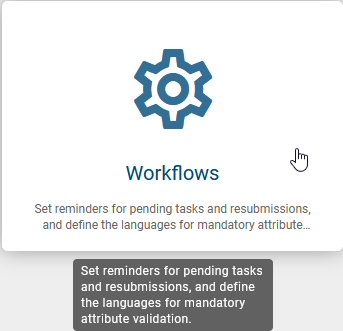
After selecting the tile, you can choose the validation scope for mandatory attributes from the available options:
Arbitrary content language: The mandatory attribute must be maintained in at least one content language.
Only enabled default content language: The mandatory attribute must be maintained in the activated default content language, even if it has been maintained in other languages.
All enabled content languages (default setting): The mandatory attribute must be maintained in all enabled content languages.
Note
You can define the default and content languages in the administration.
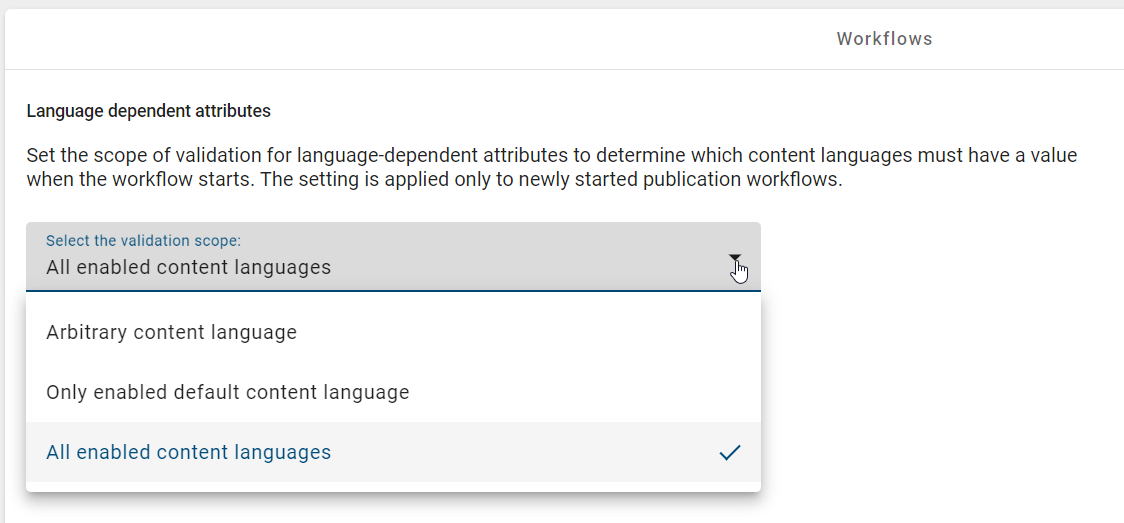
When a new validation scope is selected, the publishing workflow verifies that all mandatory language-dependent attributes for entities and diagrams comply with the selected scope.
Note
Please note that the new validation scope will only apply to a publishing workflow that has been started after the change was made.
Hint
Please note that the functions of the Workflows tile are not available in the mobile view.
How can I set the workflow task reminder?
You can also configure a reminder interval for unfinished tasks in the Workflows tile. Therefore, click on Reminders to display the setting options for Task reminders.

This section allows you to set the reminder interval (in days) for open, unfinished tasks. The default interval is 7 days, meaning that users with open tasks will receive reminders once within this timeframe. You have the flexibility to customize the interval by entering your preferred number of days in the corresponding field. The changes to the reminder interval take effect immediately and will be applied to all new tasks. A notification confirming the successful changes will appear at the bottom right of the screen.
Hint
Please note that the functions of the Workflows tile are not available in the mobile view.
How can I set the resubmission reminder?
In the Workflows tile, you as an administrator can configure when reminders for upcoming resubmissions should be sent. To do this, click on Reminders to display the setting options for Resubmissions.

The time (in weeks) for resubmission reminders is specified here. The respective responsible individuals receive a one-time notification at the chosen time regarding the remaining validity period. Changes are saved instantly, and a notification confirming the successful update is displayed at the bottom right of the screen. This update applies to all new resubmissions.
Hint
Please note that the functions of the Workflows tile are not available in the mobile view.
MyBIC
If you are an Administrator and open the Administration menu item in the left menu bar, you will see a collection of predefined tiles. In the MyBIC tile, you can create standard favorites and make them available to your users on the MyBIC page.
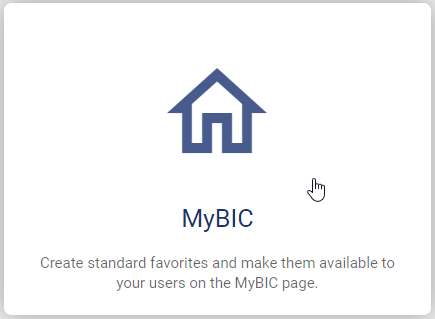
After clicking on the tile, a list will appear sorted in descending order based on the creation date. This list displays the names of the standard favorites and the assigned user groups. If the name is not available in your browser language, a corresponding hint will be provided.
Hint
Please note that the functions of the MyBIC tile are not available in the mobile view.
How can I create a new standard favorite?
When you open the Administration menu item in the left menu bar as an Administrator, a collection of predefined tiles is displayed. In the MyBIC tile, you can create standard favorites and make them available to users on the focus-specific myBIC page.
After clicking on the myBIC tile, a list of existing standard favorites will be displayed in descending order by creation date, if available. You can create a new standard favorite using the Create favorite button at the bottom right.
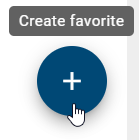
This will open a dialog in which you must select a focus, enter the URL of the search result or diagram for the standard favorite, and enter a name. Use the Select focus selection field to specify on which focus-specific myBIC page the standard favorite should be displayed. Optionally, you can also enter user groups and the name in other languages.
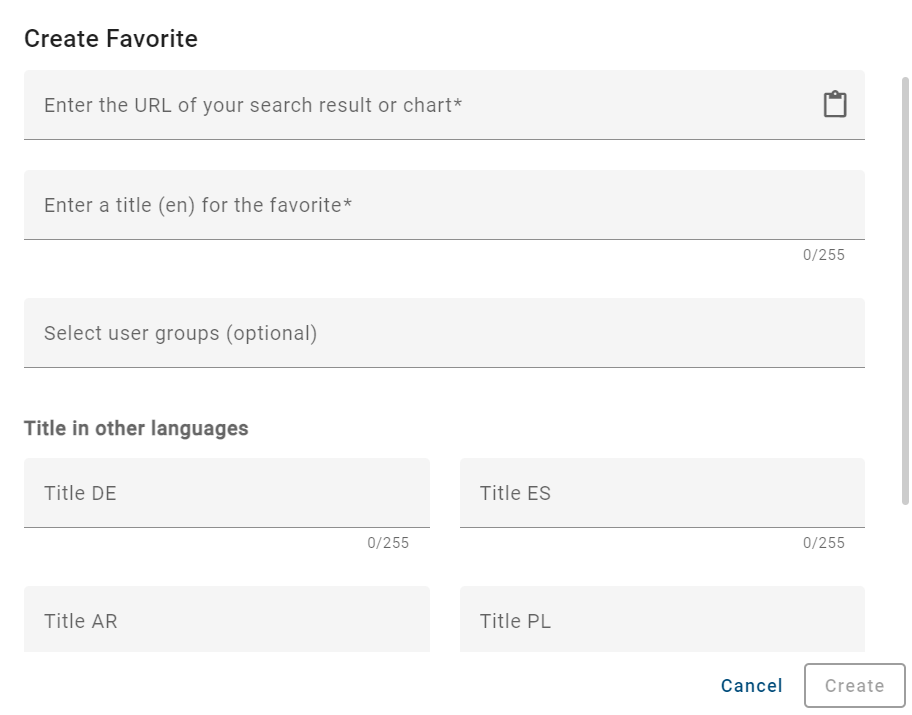
Once you have filled in at least all the mandatory fields, you can create a new standard favorite by clicking the Create button. The newly created standard favorite will then appear as the first entry in the list in the language of your browser and user interface. To discard your input, click the Cancel button.
How can I delete a standard favorite?
If you are an Administrator and open the Administration menu item in the left menu bar, a collection of predefined tiles will be displayed. In the MyBIC tile, you can delete existing standard favorites.
To delete a standard favorite, there must be at least one standard favorite. Click on the standard favorite you want to delete in the list to expand it.
You will then see the option to delete the standard favorite at the top right of the entry.

After clicking on the Delete favorite option, the standard favorite will be deleted immediately and removed from the list.
Print
Reports
In the Reports tile, you can create reports and configure existing reports.
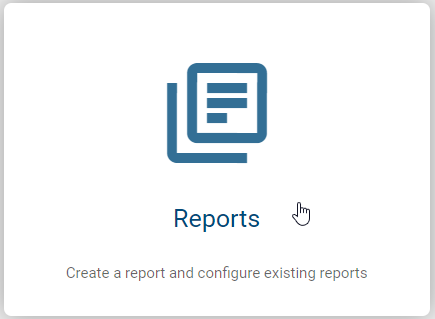
After clicking on the tile, a list of all existing reports is displayed.
Hint
Please note that the functions of the Reports tile are not available in the mobile view.
How can I view my available reports?
BIC Process Design provides various reports on diagrams, categories, and catalog items. You can export these reports if needed. As an Administrator, you can manage these reports via the report descriptors.
To do so, navigate to the Administration menu item in the left menu bar and click the Reports tile. All currently available report descriptors will be displayed. If a descriptor restricts reporting to specific diagram or object types, the IDs of those types will be shown below the report’s name.

Once you select an entry, you will be taken to the editing area, where you can configure the report or create report templates as needed.
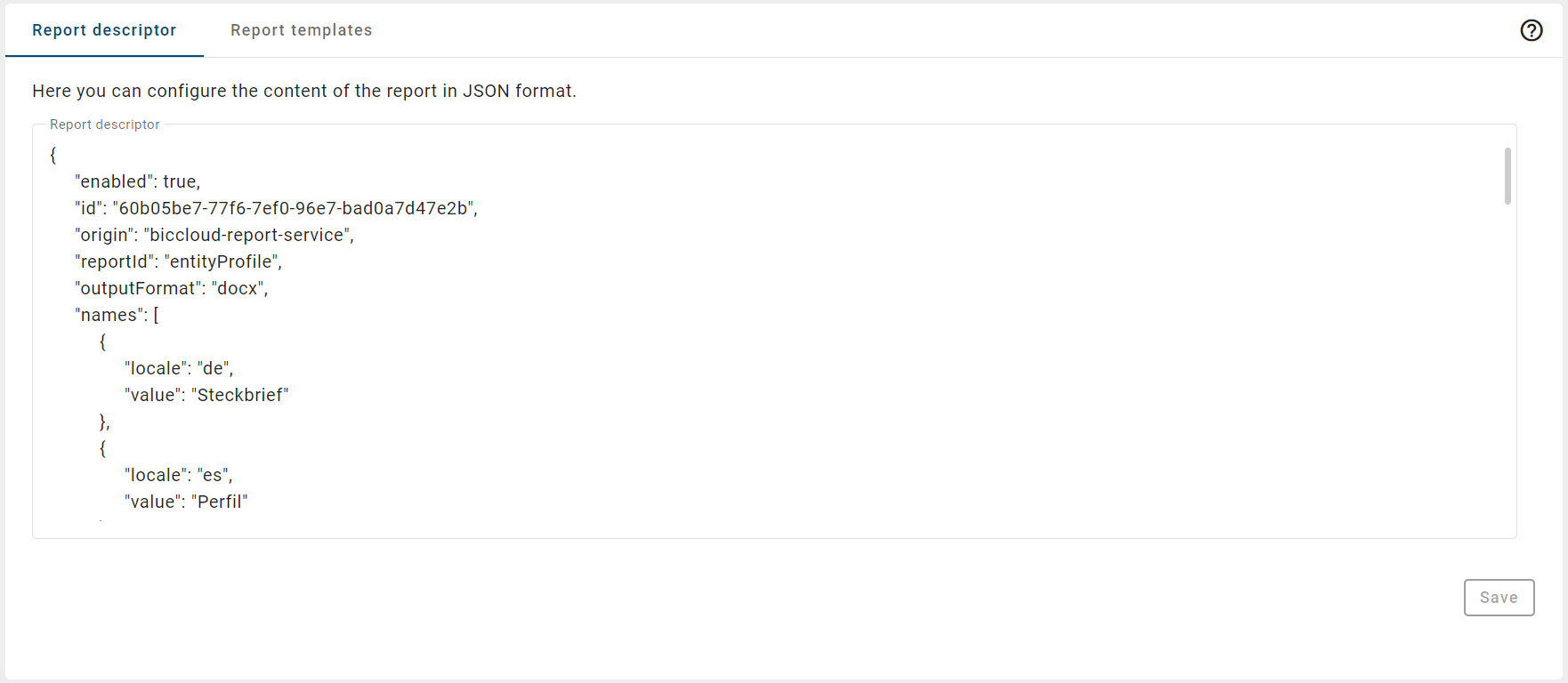
Hint
Please note that the functions of the Reports tile are not available in the mobile view.
How can I create a new report?
After clicking on the Reports tile, you will find the button Create new report located at the bottom right corner of the screen. Click on it to create a new report.
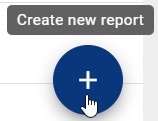
This will open a dialog window where you can configure the report’s content in JSON format.
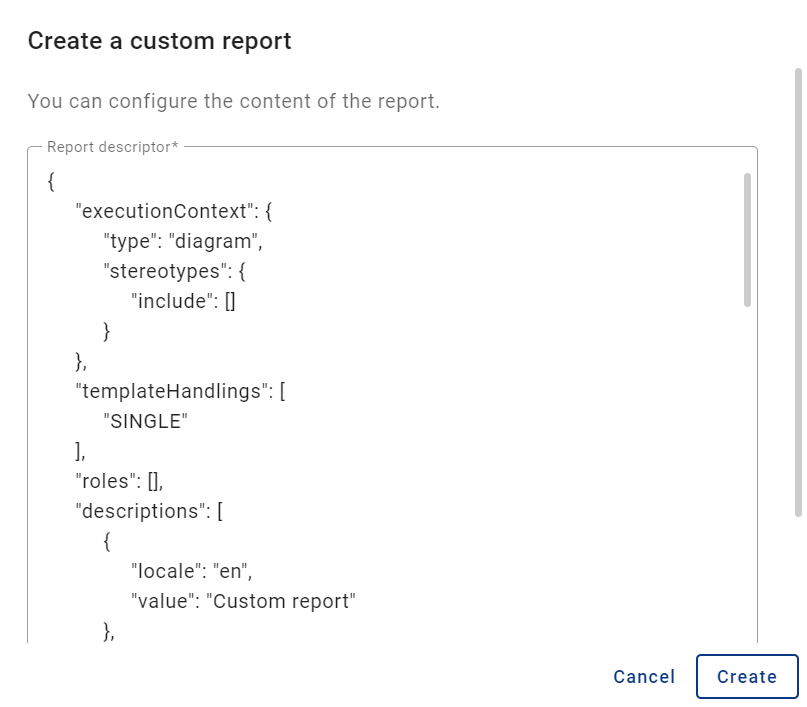
Click on Create to create your custom report. To cancel the process, click on Cancel.
Once the report is created, you will be redirected to the details page of the new report, where you can further configure the report as needed.
How can I configure an existing report?
To configure an existing report, there must be at least one report in the list. When you click on a report, you will be taken to the report descriptor where you can configure the report in JSON format.

In the descriptor editor, you can change the following settings:
Availability: You can activate or deactivate a report for diagrams or categories for BIC Process Design by using the variable enabled. The report is activated if the value is set to “true”. To deactivate the report you have to change the value to “false”.
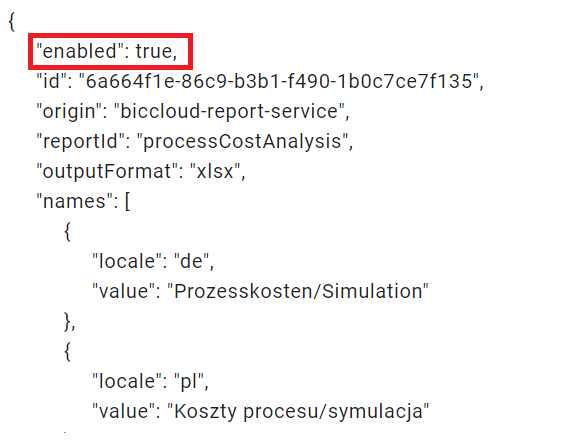
Format: You can use the outputFormat variable to specify the format of the output of the report. The following formats are supported for the respective reports:
Profile (diagram): docx, pdf, pdfa, pdfa2b
Profile (catalog entry): docx, pdf, pdfa, pdfa2b
Manual: docx, pdf, pdfa, pdfa2b, html, mhtml, txt, odt, rtf
Manual with assignments: docx, pdf, pdfa, pdfa2b
Matrix Report: xlsx, pdf, pdfa, pdfa2b
Process costs/Simulation: xlsx, pdf, pdfa, pdfa2b
Here pdfa corresponds to the “PDF/A-1b” format and pdfa2b to the “PDF/A-2b” format.
Note
The format pdfa does not support images with transparency. Therefore it is recommended to use pdf2b if images and icons should be present in the report.
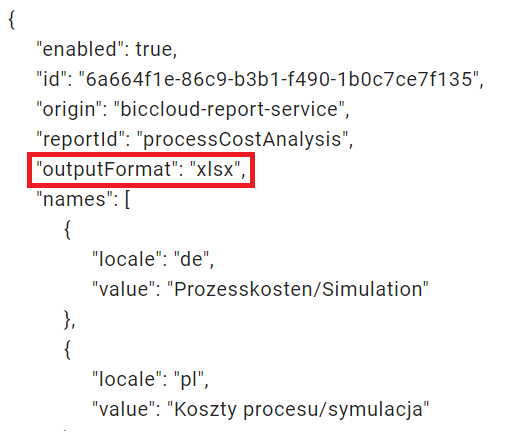
Names: The variable names specifies the displayed name of the report within the user interface of BIC Process Design. For each language that is supported by BIC Process Design you can set a different value. This difference can be seen as soon as the browser language has been changed.
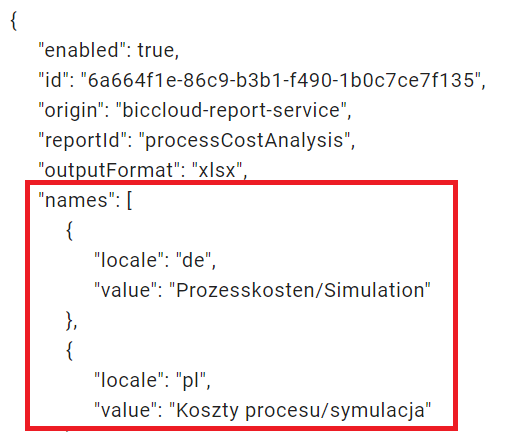
User roles: With the roles variable you can define the user roles which are authorized to export the respective reports.
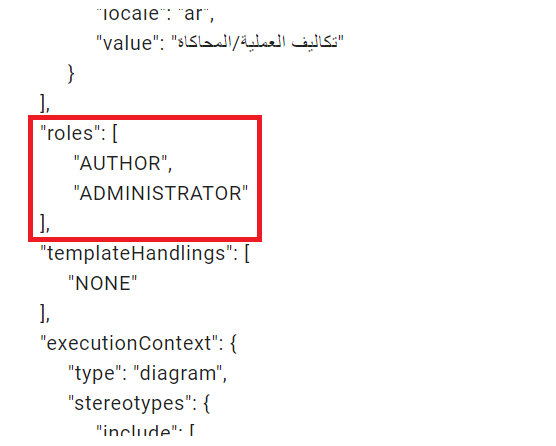
Context: Here you can specify whether the report is available in the context of a diagram or a category. You can do so by setting the value of the variable type to “diagram” or “category”. Within one descriptor, there can only be one value for the context variable. Therefore, there are two different descriptors for reports that should be available in both contexts. These can be edited separately.
Hint
Please note that the entire report template for “category” must be adjusted. Otherwise the report template will always fail.
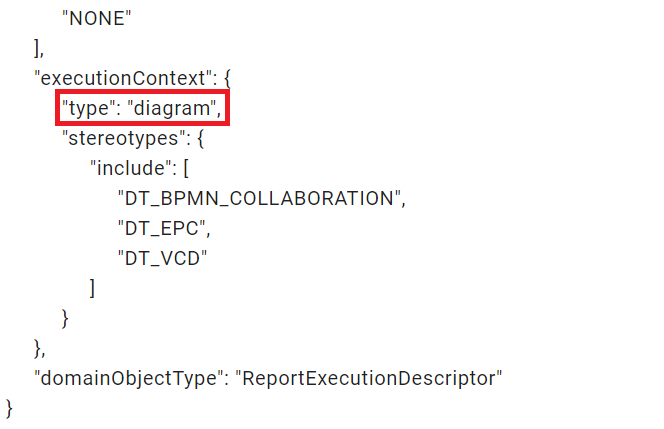
Stereotypes: For reports that are available in the diagram or catalog entry context, you can define which diagram or object types are allowed to use this report. This is possible by writing the IDs of the respecting diagram/object types into the include variable. The report is available for all types if no value has been set for this variable or if the variable contains the value “all”.
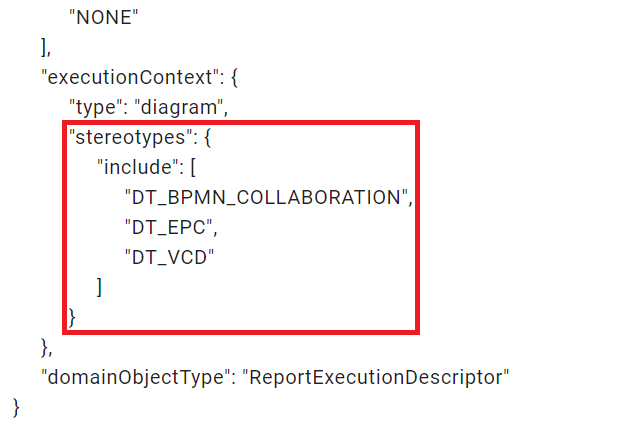
Once you have made changes and adhered to the JSON format, you can click on Save. Your changes will then be saved immediately.
If you want to exit the report descriptor without saving your changes, you will receive a notification.
How can I upload a new report template?
To upload a new report template, there must be at least one report in the list. Click on a report to access its details, then select the Report templates tab. From there, you can find the Upload report template button located at the bottom right of the screen.
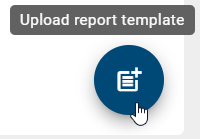
Once you click on the button, you can select and open a file from your local storage. A dialog window will open where you can select the diagram type and language for the uploaded file. All diagram types of the current method and all content and alternate languages defined in the administration are available for selection.
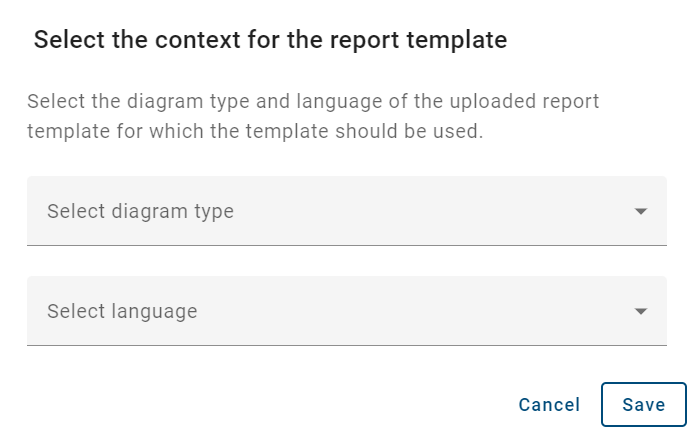
Click on Save to upload the report template. The uploaded report template will then appear in the list, sorted alphabetically by file name. To cancel the process, click Cancel.
How can I update an existing report template?
To upload a new report template, there must be at least one report in the list. Click on a report to access its details, then select the Report templates tab. If there is at least one report template available, click on the context menu (three dots) of the report template to be updated and select Upload.
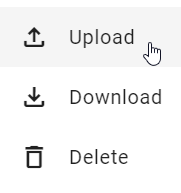
Afterward, you can select a new file from your local storage to update your report template. The file name will be adjusted according to the new file, while the diagram type and language will remain unchanged.
How can I download a report template?
To download a new report template, there must be at least one report in the list. Click on a report to access its details, then select the Report templates tab. If there is at least one report template available, click on the context menu (three dots) of the report template to be updated and select Download.
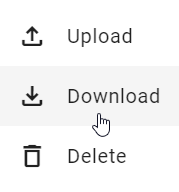
The report template will then be downloaded immediately.
How can I delete a report template?
To upload a new report template, there must be at least one report in the list. Click on a report to access its details, then select the Report templates tab. If there is at least one report template available, click on the context menu (three dots) of the report template to be updated and select Delete.
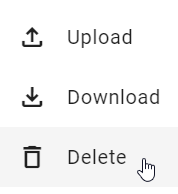
The report template will then be immediately and irreversibly deleted.
Note
Please note that only custom report templates can be deleted. If you have updated a standard template and want to delete it, the report template will be reset to the standard template.
Which fonts are supported by the report engine?
Be aware that in the process of generating a .pdf file only certain fonts are supported by the report engine. If a font is used that is not supported, it will be replaced by a fallback font in the .pdf file. This can lead to formatting losses and a change in the total number of pages in your .pdf file. As an example this can be relevant for the configuration of report templates or the provision of attachments in the publication as .pdf files.
The supported fonts are listed below:
Arial Black
Arial (Bold, Italic, Bold Italic)
Comic Sans MS (Bold)
Courier New (Bold, Italic, Bold Italic)
Georgia (Bold, italic, Bold Italic)
Impact
Times New Roman (Bold, Italic, Bold Italic)
Trebuchet (Bold, Italic, Bold Italic)
Verdana (Bold, Italic, Bold Italic)
Webdings
Hint
If you would like to use fonts that are not listed here, please note that you can embed the fonts used in your document.
Details
In the Details tile, you can configure the profile for diagram and object types and set the visibility of the profile in the diagram view.
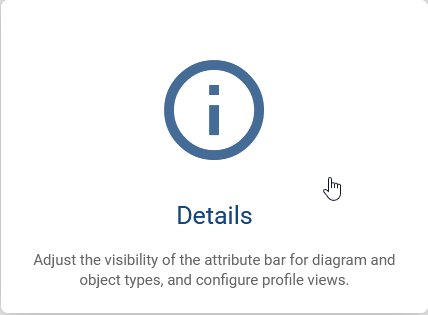
Hint
Please note that the functions of the Details tile are not available in the mobile view.
How can I display the attributes in a diagram?
All attributes are displayed in the diagram in the Details tile in the Administration menu item, regardless of the Profile configuration. This also includes the setting of the visibility of the profile.
How can I change the visibility of the profile?
If you open the menu item Administration in the left menu bar as Administrator, a collection of predefined tiles is displayed. In the Details tile, you have the option to configure the profile for diagram and object types, as well as set the visibility of the profile in the diagram view. Click on a list entry for an object or diagram type to open its detailed settings.
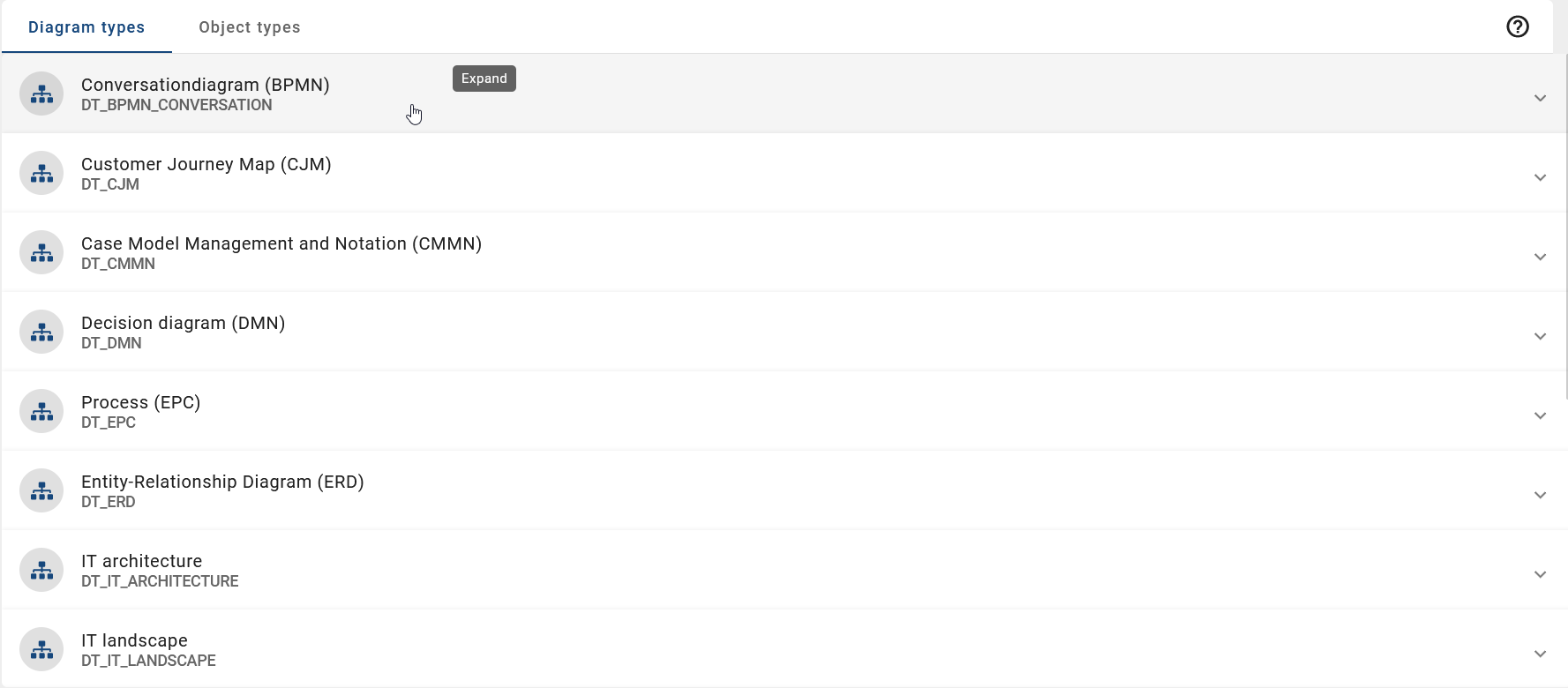
The current visibility status is displayed in the Display profile view field. Click on the corresponding toggle switch to change the active setting. Your changes will then be applied directly.
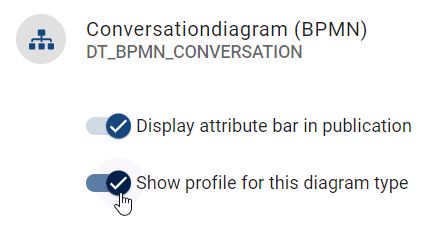
Click on the diagram or object type to return to the overview. If the switch is activated, the Profile will be visible to all users in the diagram view. If the switch is deactivated, no details about the object or diagram type will be displayed in the Profile.
How can I configure the profile?
In the Details tile, you can configure the profile for both diagram and object types. Initially, you will see the default settings, which you can then modify. This includes attributes such as description, as well as relationships to other object types like responsible and contributing roles, input, and output.
To modify the profile, click on a list entry to open its detail settings. If necessary, adjust the visibility of the profile. You can then view the existing configuration in the editing field and make any changes needed.
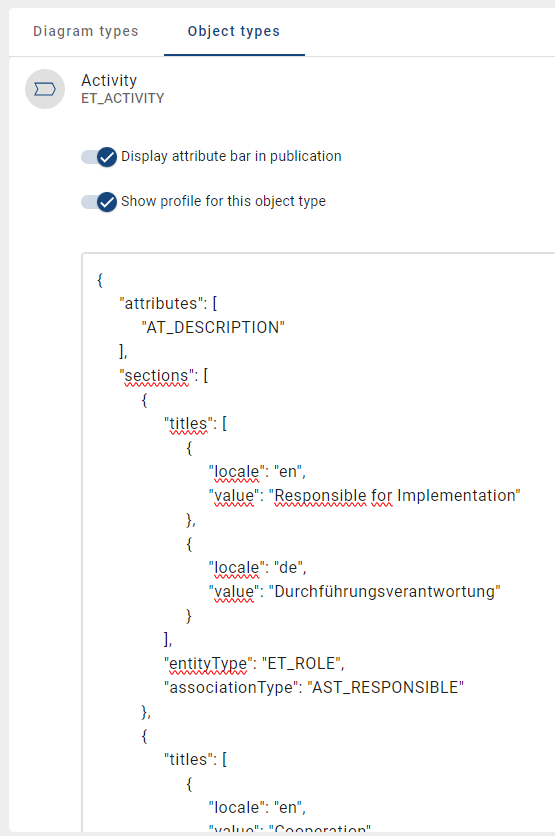
Attributes: You can add or remove diagram or object attributes using the attribute type ID. In the following example, the object attribute “Name” is displayed next to the “Description”. To do this, the attribute type ID must be added to the
"attributes"section:
"attributes": [
"AT_DESCRIPTION",
"AT_NAME"
],
Associations and entities: In
"sections", specific relationships to object types, selected association types or specific object types can be output individually. Its representation takes place in various subsections named"titles", in which the issues and designations in the profile are defined. The following subsection example looks for “roles” contained in the diagram with “C - Consulted” the relationship to another entity. For this, the ID of the"entityType", in this case"ET_ROLE", and the"associationType", here"AST_CONSULTED", must be specified. These roles are then listed in the profile section named"Cooperation"in English browser language and"Mitwirkung"in German browser language.
{
"titles": [
{
"locale": "en",
"value": "Cooperation"
},
{
"locale": "de",
"value": "Mitwirkung"
}
],
"entityType": "ET_ROLE",
"associationType": "AST_CONSULTED"
},
If only one relationship type or entity type is requested, the other type should remain undefined by "".
To save your changes, click on the Save button located at the bottom right within the detail settings. You may need to scroll down to locate the button. Subsequently, the configuration will be validated, meaning the syntax of the JSON structure will be checked, and upon successful validation, it will be saved.
Clicking on the diagram or object type will return you to the overview.
The profile is also displayed in the diagram view under the Details tab in the right sidebar. All user roles can access the profile.
Hint
Please note that if the editing field of the diagram or object type is empty but the Display profile view button is activated, no details are displayed in the Profile in the diagram view for the diagram or object type.
Tip
For a list of existing stereotypes and related IDs, see this section.
Translation Service
If you click on the menu entry for Administration in the menu bar, you will see the tile Translation Service.
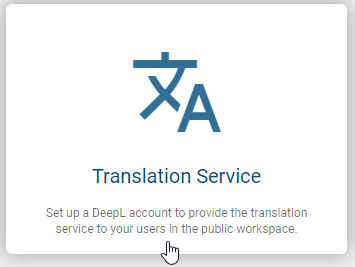
You have the option to grant your users access to the translation service in the public workspace by linking your DeepL account. Your account must be created through DeepL.
How can I test my DeepL API configuration?
In the Translation Service tile, you have the option to enable or disable the Translation Service Connector.
Clicking on the tile will take you to the configuration page. Here, you can enter the API key from your DeepL account and test the access. If no API key has been entered, the option to test the configuration will be disabled at this point.
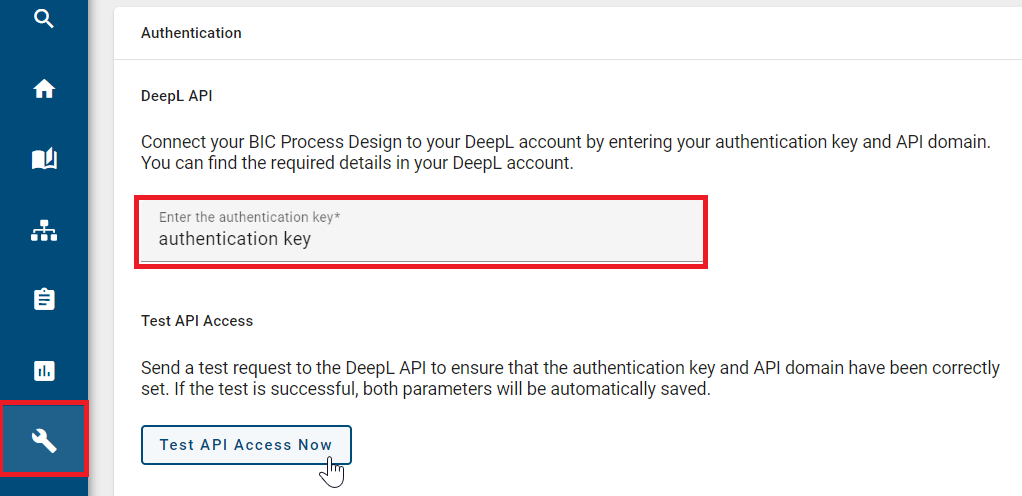
Note
With the test option enabled, you will send a test request to the DeepL translation endpoint. The entered API key will be used for authorization. If the authorization fails, you will receive an error message.
How can I remove my DeepL API configuration to delete my login data?
If your DeepL credentials are linked, you can delete the DeepL API configuration and login information.
Deleting the login information will remove your access credentials from the database. After requesting deletion, you will receive either a success message or an error message indicating the current status.
Note
Please note that the option to delete the login information is disabled if no login credentials are linked.
Access restrictions and scope definitions
How can I set access restrictions for diagrams?
As an Administrator, Editor or Author (if the author is specified in the diagram’s Author governance attribute), you can define access restrictions for diagrams. To do this, click the Diagrams menu item in the left menu bar, select a diagram and check it out. In the Details panel on the right, you will find the Restricted access input field within the Governance attribute group.

Only members of the selected user group, selected users and governance participants have access to the respective diagram. These restrictions apply regardless of user roles, meaning administrators can also be excluded. If the input field is left empty, no access restrictions apply.
Diagrams with access restrictions are displayed in the digram list. However, if a user without access tries to open a restricted diagram, an error message will appear.
Hint
Please note that if you define an access restriction that excludes you, you will no longer have access to the diagram once it has been checked in.
How can I set access restrictions for repositories?
As an Administrator, you can set access restrictions for repositories. To do so, click the Administration menu item in the left menu bar and select the Repositories tile. A list of all available repositories will then appear.
Open the context menu of an existing repository and select the Edit properties option.

A dialog then opens. There you can select different users and user groups via the suggestion list in the Access restriction input field. The corresponding catalog item person or organizational unit will then be set for the access restriction.
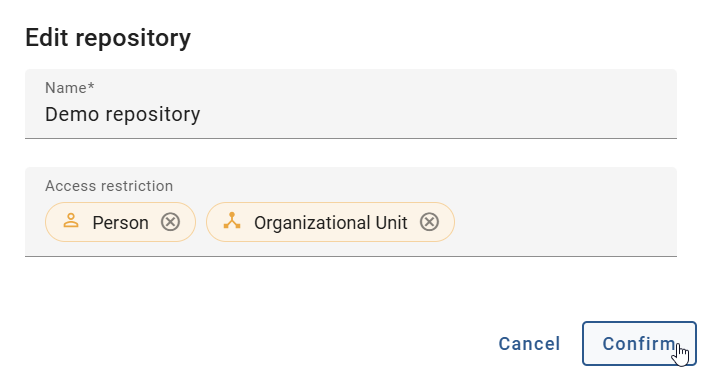
By clicking on Confirm, only the selected persons and organizational units representing users and user groups will have access to this repository. These restrictions apply regardless of user role, meaning administrators can also be excluded.
If the Access restriction field is empty, all users have access to the repository, depending on their respective user role.
Tip
You can also search for the user’s e-mail address. If a user is selected from the list and is not linked to a catalog object of the type “person”, a new catalog item will be generated with the name and the e-mail of the given user.
Hint
Please note that the access restrictions set for a repository can prevent navigation to the contents of a repository within the user interfaces. To reliably control access to individual repository contents, it is recommended to apply access restrictions directly to specific content elements such as diagrams and catalog items.
Note
If you have defined a restriction, which does not include yourself, you cannot access this repository any more as soon as your setting has been saved. Please be aware that such a case can also occur when renaming a user group.
How can I unlock a diagram?
The Administrator user role allows you to manually unlock diagrams. For example, you can use it if a user has not checked in a diagram and will be absent for a long time. However, this procedure may result in data loss because unsaved or checked-in changes by the locking user are not saved on the server but rather locally in the browser. Therefore, try contacting the locking employee first.
To do so, click on the Diagrams menu item in the left menu bar and select a locked diagram. Instead of the Check out button, a lock symbol will be displayed. Click on the symbol to find the Unlock diagram option. Select this option to manually unlock the diagram and make it available for other users to edit again.

Warning
The user who locked the diagram previously can no longer check it in. They must discard their local changes before checking out and edit the diagram again.
How can I define the scope?
With the attribute Scope you can allocate users and user groups of your enterprise to diagrams and catalog items. These units will then be informed as soon as the diagram or the catalog item has been published, a new version is available or if it has been depublished.
The scope also has an impact on modeling in the diagram. The suggestion list of catalog items and their attributes only contains entries, that have the same scope as this diagram or that have no scope at all. For a detailed description please refer to the associated chapter.
To use these functions you must first connect an user or a user group with the diagram attribute or catalog item attribute Scope.
Tip
You can find the attribute in the section Governance. Depending on the method settings, this attribute exists for objects and therefore catalog items. In general, a scope can be associated with multiple users and user groups.
